
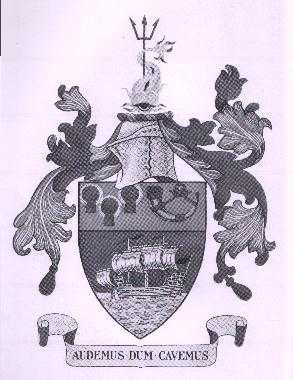 |
 Wallasey's entry in the Doomsday Book Walea (1086). Island of the Welsh or Britons. Known during the medieval period as Kirkby Waley. Walleye 1259; Walezey 1534; Wallowsy 1721 |
|
Wallasey Related Pages Ashville Wallasey Parish Church Fire Wallasey Blitz Wallasey RAF Hero The Wallasey Wreckers & The US Pennsylvania Leasowe Leasowe Castle History of the Ferries New Brighton New Brighton Ferry Seacombe & Poulton Seacombe Ferry Liscard Egremont Egremont Ferry Wallasey Village Moreton Leasowe Horse Racing in Wallasey |
On this page:
Wallasey History My thanks to the members of the Mersey Ferry Group on Facebook and to David Langton, Jeanette Land, David Garbutt, Robbie Quinn, Brian Gill, Robert Hayden Foy, Mersey Ferries.Tony Franks Buckey, and many others. David Langton actually does talks on the Ferries. I saw him in October 2012 in the Floral Pavilion in New Brighton doing such a talk. Well worth a visit. David is a former skipper on the Ferries. Thanks to Noel Smith for his History of the Fire Bde. https://www.facebook.com/groups/457771247574359/ - North Wirral Group |
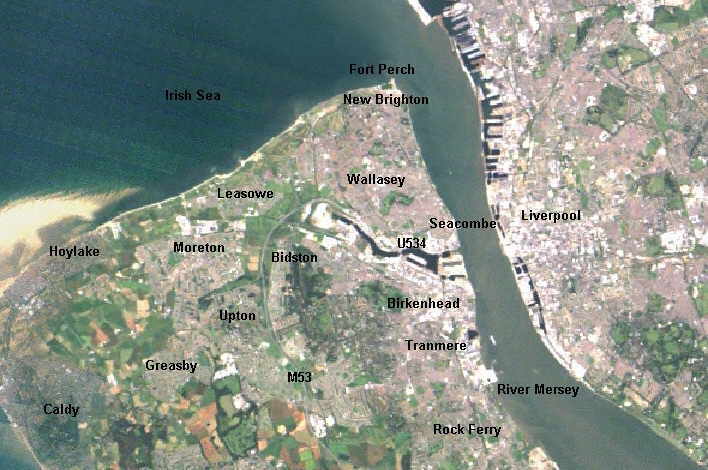 |
|
| TOWN HISTORY | |
|
Wallasey means the "island of Welshmen or Britons", a viking word, but its literal translation can be the word of "Welshmen" as strangers. When the Saxons spread across what became England, they pushed minority tribes etc out into the less accessible regions. Wallasey was one such region. Situated at the top right hand tip of the Wirral Peninsula, Wallasey was bordered on one side by the river Mersey, on the other by the Irish Sea, to the south by a large area of marshland known now as Bidston Moss and the waters of the Wallasey Pool inlet to the west by it was protected by marshland and mobile blowing sand. It was almost quite literally an "island". The Moss was not an easy place to cross. Visitors from out of the region would have been very hard pressed to find a way across. There was in fact one landward passage that led into Wallasey. Starting from Leasowes lighthouse, in Moreton, there was a long narrow lane (now Green Lane) that ran along behind the dunes and in front of the most fertile land in the area, known as "the market gardens". Now, on the opposite side of the same market gardens, runs Leasowe Road. Where I lived, Moreton, did not actually become part of Wallasey until 1928, but that's on my Moreton page. The Saxons never reached Wallasey, hence their name for the region. The situation was not dissimilar to the Celts in Cornwall, or the highlands or indeed, Wales. Very little is known about early Wallasey dwellers. There have been a few finds of animal bones, an adze hammer, a bronze palstave (right) and, in 1864, at Leasowe, of a complete skeleton displaying "characteristics and peculiarities of an original race, or savage tribe." (Sir Edward Cust). The adze hammer was found in 1936 in Brickworks on Leasowe Road, 4 - 5 feet down in blue silt on an old course of the River Birket. It was thought that a flint factory had been found at Red Noses, New Brighton, but later decided that it was most likely the products of trade from Co Antrim, the nearest source of this type of flint. The names Wallasey, Seacombe and Liscard are the only remnants of the Britons who we presume lived in the area. There is also evidence of the Norsemen who lived in the region names like Breck and Kir(k)by and the thwaites and holms of Bidston Moss. Vikings were given the area of North Wirral by the Queen of Mercia, but they attacked Chester, causing the Queen to raise a saxon army which vanquished the Vikings at Brunanburh (Bromborough) driving them out of the Wirral across the sea and as a result, England was born. The very first documented reference to Wallasey is from the Doomsday Book. Bidston Moss has pathways known by many locals but not further afield. Two whale jawbones were recorded as forming a bridge at one point on the Moss. Liscard was central to this "island". Black Rock stood alone for many centuries, local fishermen were all that frequented the area (and smugglers later on) until, in 1830, New Brighton began to appear. Wallasey began to be the dwelling area for rich Liverpool businessmen and ship owners. On the opposite side of the Moss, stood the village and parish of Bidston, Bidston Hill and Claughton. To the south of Wallasey Pool stood Birkenhead Priory. The remains of this today stand between Woodside Ferry and what was Cammell Lairds shipyard. Wirral was
disafforested by a Charter of Edward the black Prince, and although the exact
date of this is unknown it was probably in 1376. The first local name to appear
in the Hundred Court as a plaintiff is that of john de Waley, whose cattle in
1394 were found wandering at large and were impounded by the bailiffs of the
court.7 As early as 1399 two Wallasey men, John Litherland and John de Meoles,
were among those appointed as Conservators of the Peace by the Prince of
Wales. The appointment of these Conservators (the forerunners of the Justices of
the Peace) was made necessary owing to the trouble between Richard II and Henry
of Lancaster, and the risings in Wales, reacting on Cheshire, which was in a
very disturbed state} These two were again appointed in 1403 when the fear of
invasion of Wirral by Owen Glendower made it necessary to appoint watches, and
to make hedges, ditches, and other impediments on the sea coast of Flint, to
repel the invaders. Taxation was not unknown even in the Middle ages, Richard
II imposed a fine of 600 marks levied upon the townsfolk of The Wirral. *Wapentake. Sub division of a Riding. Equivalent to a Hundred. Disused after 1900. The word was probably derived from an assembly or meeting place, usually at a cross-roads or near a river, where a vote was taken by a show of weapons, "weapon touch". |
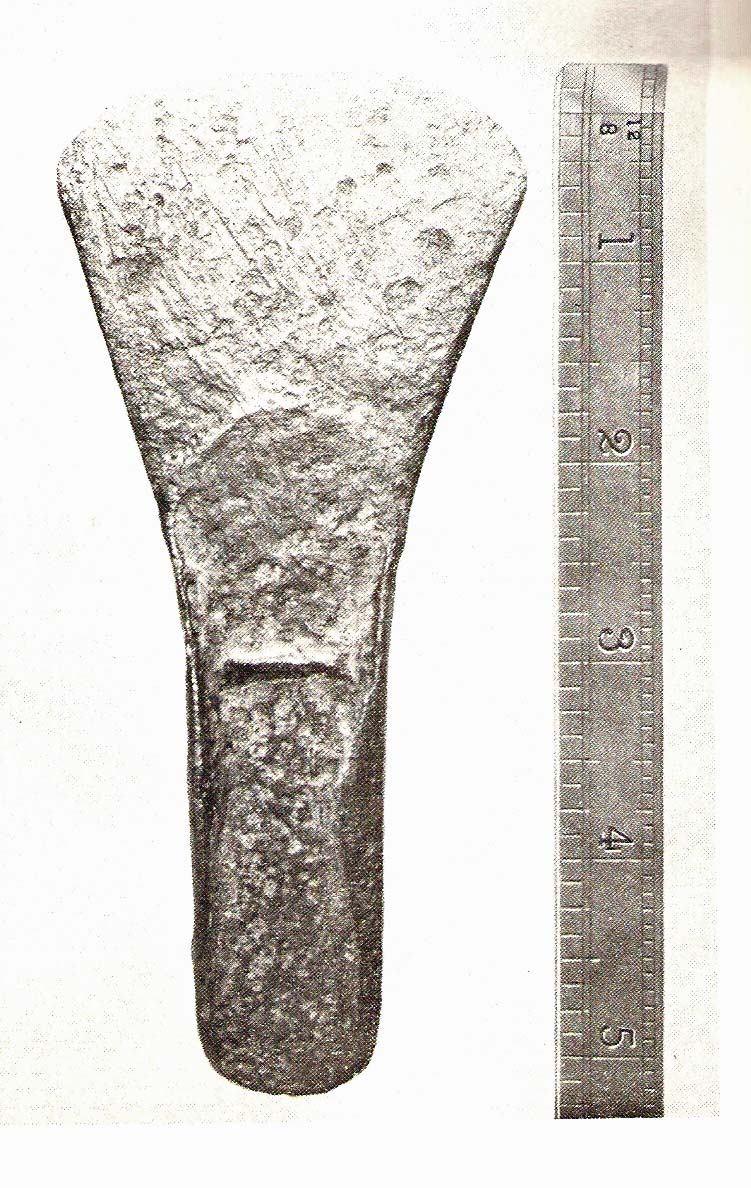 Palstave 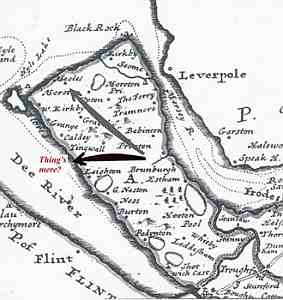 Viking Escape Routes |
|
In December, 1400, a number of Wallasey men, Thomas Le Taylour, john Scargill, Thomas le Prestesson, Henry Gamull, Robert Tyruppe and John de Hulle, were fined for stealing at Birkenhead from Robert Molyneux and his fellows fourteen oxen, cows and calves which Robert had brought from Wales, where he had taken them from rebels. The bedell of the court in 1408 was a Wallasey man, ]ohn le Barker. Four years previously he and another man had come to Chester from Wrexham to avoid joining the rebels. This was their story: nevertheless, they both had to do fealty to the Earl and find a surety. Thomas Broune, a Wallasey yeoman, shared the lease of the court in 1415, for which privilege he apparently paid £4 6s 8d. Later he went over to France to serve in the army of King Henry V. In 1561 Wallasey had a list of four persons who kept Alehouses. They were: Robert Stanney
de Kyrkeby-Walley One other is listed as Eleyne Ensdall de Secum. The four were probably, but not of a certainty, the Cheshire Cheese, Wallasey Village; The Boot Inn, Liscard, the Seacombe Boathouse and the Pool Inn, Poulton. All were demolished and rebuilt on slightly different sites but the Boathouse Seacombe vanished completely. In the mid 1800s, Leasowe Road was created purely so that they could transport stone being quarried from the Breck to Leasowe Shore. Indeed, stone from the Breck was also used to make Leasowe Road. The road from St Hilary's Brow to the Breck was cut through the rock by the contractor. St Hilary's. (Own page) From the sea and the shore, from Moreton to the fields in between, St Hilary's was a most prominent landmark for all to see. Although still there, buildings and estates now block the view for many. The Church stands on top of the most prominent natural feature, The Brow. For centuries there has been a church on this site. See the newspaper report below. The name dedicated to this church is quite rare throughout the whole of Great Britain. There are only 8 churches of this name. With the exception of Lincolnshire, all are situated in Celtic lands. As Wallasey was christened the "isle of Welshmen" I suppose we could claim celtic shores for our own St Hilary. The Scandinavian name for Wallasey is Kirkby in Wallea or Church in Wallasey; this tells us that a church existed here already, in the 10th century, which is when the Norsemen arrived. There is another, lesser known, theory that the name St Hilary is a mix up with St Elian, a 6th Century Welsh saint who was often confused with St Hilary of Poitiers and that a church on this site could have been dedicated to him approximately 400 years earlier. Whichever theory hold water, there has been a church on this site since, at the very least, the 6th century. No remains whatsoever can be found of the earliest church, especially as we now consider that it was quite likely constructed of wattle and daub or wooden. The earliest remains found to date have been Norman. These were fragments of a font, the bowl of a piscina, (similar to that pictured right), an arch stone and portion of a doorway. It is likely that the builder of the Norman church was Robert de Rodelent. |
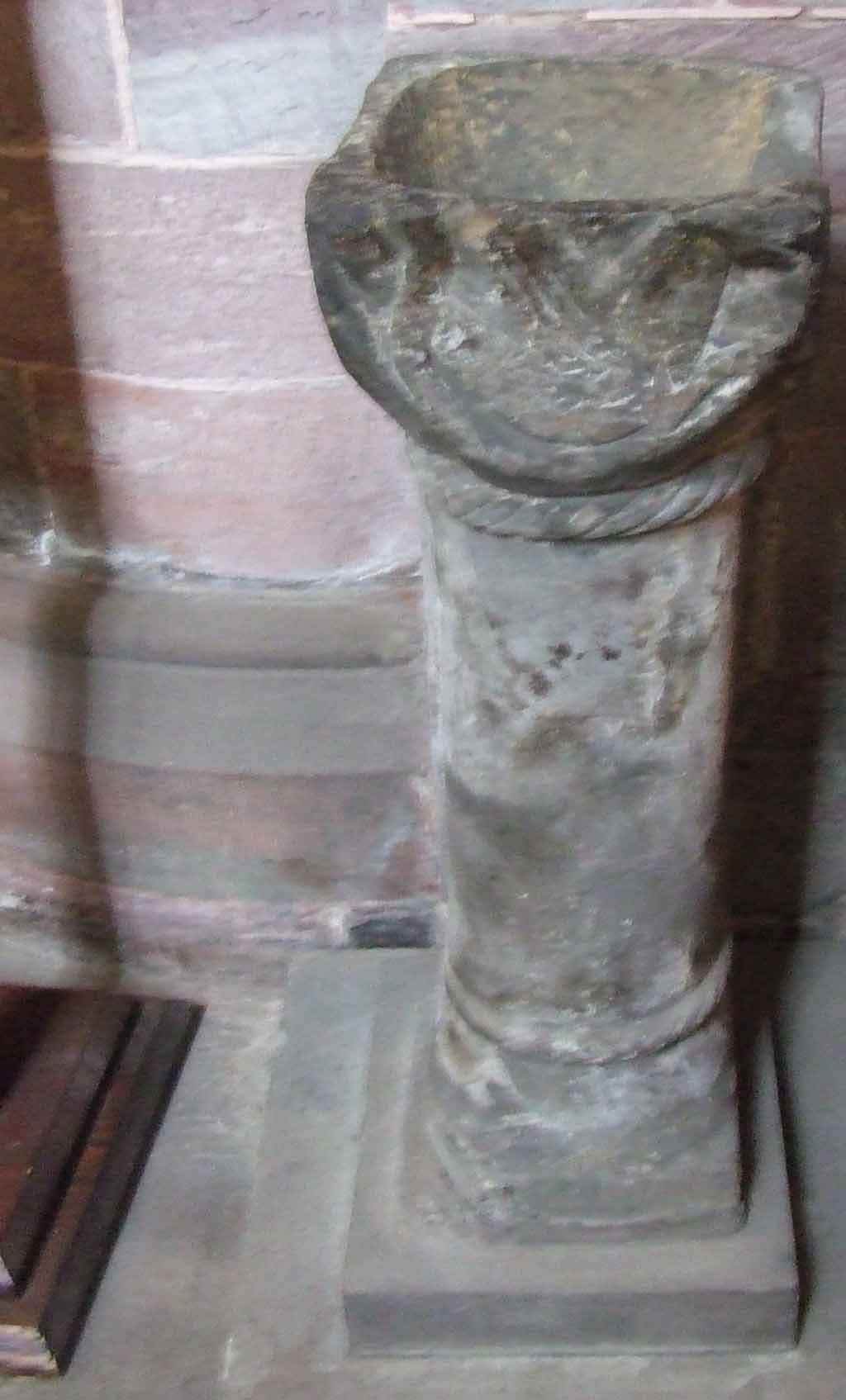 A picture of mine of the Piscina in Shrewsbury Abbey |
|
At the time of Henry II it was recorded that William of Wallasey donated two fields to the church in exchange for a burial in the chancel. Apparently a rebuild took place in the 20 years following 1162, and again around the years of Edward I or II. The tower was added in 1530; this was the sole remnant of the church of that period, the survivor of the fire of 1857. The parish register starts in the year 1574. In 1658 records are available showing accounts. The sum of 3s being spent of a pewter basin. In 1660-61 a new pulpit was provided and 2s spent on manufacturing and placement of a Vane on the "steeple" (did the tower have a steeple?). In 1662, William Coates and his son were paid the sum of £3.10s.0d for plastering and whitening the church, for painting the commandments and the lord's prayer and scripture extracts for for placing the King's Arms. In 1692, Thomas cotton was paid 2s for repairing the churchyard wall. Repairs were also carried out in 1704, Thomas Cotton is again referred to as is Samel Deane. This involved the removal of the south end window and south ile (aisle?) and the subsequent rebuild with new stone to be completed before Michaelmas next. Churchwardens are to find seven barrels of lime and to lead new stone as needful. Thomas Cotton was to be paid £3.0.0 on completion. In 1750, Henry Cotton was paid £17.17s.0d to rebuild the west end and £1.6s.8d for the provision of 80lb of lead for new windows. To Thomas Wilson the sum of £1.2s.8d for a new window and repair of old. The above work was conducted in 1751. In 1760, with the exception of the tower, the church was completely pulled down and the materials used to provide a new building. It would appear that the earlier builders had not done as good a task as intended what with all these ongoing repairs and eventual rebuild. It must have been decided that it would be far less of a cost to "start over". Stones of the Norman period when built into the new church gave evidence of an previous fire. Local tradition talks of 3 fires in the history of the building, the last being 1857. The new building was an oblong structure, akin to a barn, pews and containing galleries. It had no chancel and the east window was described as "venetian". In 1837 a transept across the east end was added which gave extra seating and also created a chancel. It was noted, in 1854, that "little of the original character of the church remained. The arcades have been removed, windows modernised, and a new perpendicular one, filled with stained glass at the east end. The 1530 tower, embattled with gargoyles and corner buttresses and course 3 light belfry windows. The only good feature is the Norman font with arches in relief on shafts and cable moulding below". |
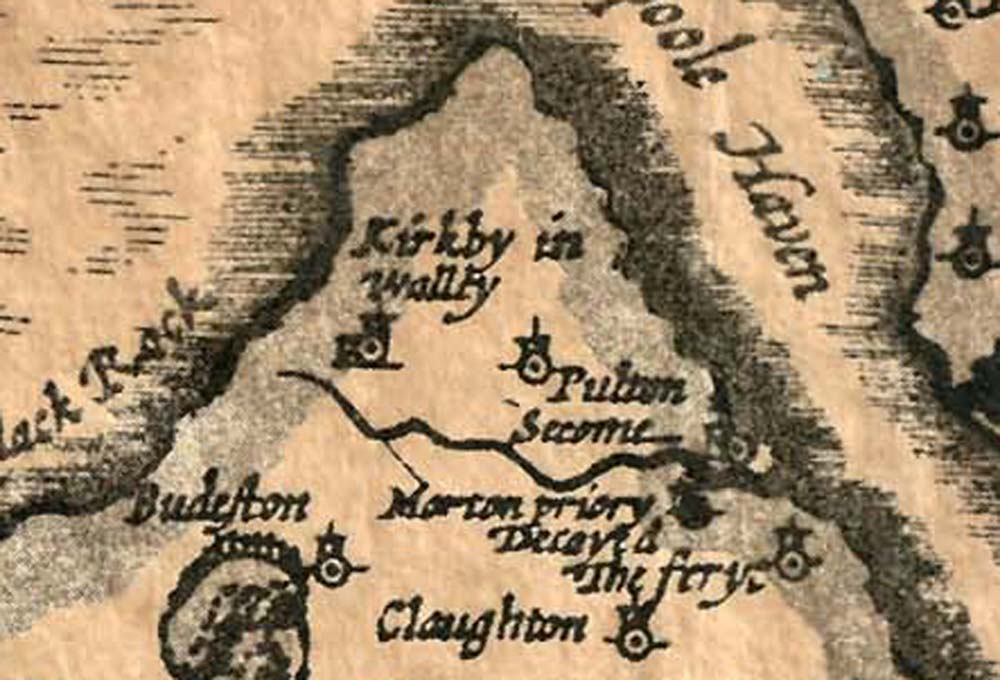 Wallasey in 1611. Bidston is Budeston. Birkenhead Priory is Mor(e)ton Priory. Birkenhead did not actually exist. The area now known as New Br00ighton has a few fishing huts, nothing else |
|
Henry Robinson wrote a complete history of Wallasey, details of which contained many stories regarding his parish. He was baptised in 1640 and died in 1727; and was a Master of the Free Grammar School. Apparently all this work was kept in a church chest within St Hillary's. This would today have been worth its weight in government tax to historians. But what happened to it all is totally unknown. He wrote An Account of Wallasey in a letter to a Mr Charles Bunbury. (see pages 353 - 360) Rise & Progress of Wallasey. If that is but an extract, I would love to see the full article. In 1753 a gent by the name of John Hough kept a journal and he recorded the costs of various items. 1753
Aug. 4th 17 pairs of plain gloves at 1/4 pr. pair 01:02 :08 One pr. loopt
gloves for the Minister. . 00:02:02 Also by the
same gent; he makes reference to January 5th 1755, "being the old Christmas
Day". Unsure of that meaning? and around the same time he makes mention of
a Wallasey past time: |
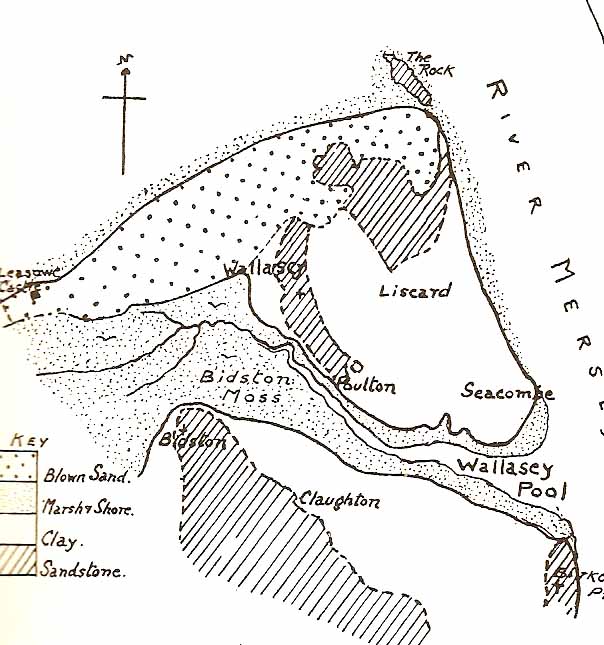 Geology of Wallasey |
| No major
roadways existed in the area, country lanes being the norm. "Seacombe in 1850,
was a country village consisting of one main street (Victoria Road), two cross
streets and a few scattered houses." By the 1890s all was changing and the
character was lost forever as industry began to unfold along towards the
Wallasey Pool. the docks. Guinea Gap got its name from the discovery of, in 1850, a number of William & Mary; George 1 and George II guinea coins were found, together with a skeleton and a sword. Another, lesser known theory says that it was "Gyn Gap", meaning a gap in the clay cliffs and it was here where a stream, risen in what is now Brougham Street, flowed down into the Mersey. I suppose the former has a more romantic ring to it (except to the poor skeleton) but was probably the latter. In 1764 John Glegg, who had obtained in April 1734 a lease of the Wapentake Court, held it on April 19th. A copy of part of the court roll still exists. Of the three hundred and four suitors, thirty-four resided in Wallasey. Here are some of the orders (right): |
WALZEY.We order every person that belongeth to the pasture ditch, if a gap be broken down, after 24 hours notis if not made up to pay 10/- for every default after notis from the constable or warned in the churchyard. We present Henry Bird, Mr. Hyde, Elizabeth Hill, John Mulinex, John Ranford, James Ranford, Thos. Bertles in 5/- each, for breach of an order of last Court for not keeping up their pasture fence. We present Joseph Robinson for taking a large tree away being a weaf (no doubt blown down by the wind and a perquisite of the lord) in one pound. LISKIT. We order that every person that turneth sheep out to the common without a separd shall pay twelve pence each sheep. (Note: weaf = stale or rotten). |
|
|
|
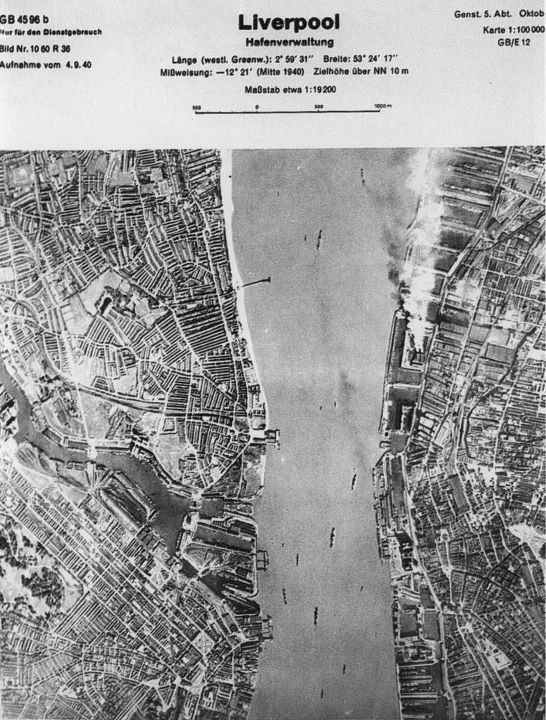 Luftwaffe recce photo of the Area - Sept 1940. The smoke rising from the Liverpool side is from the Power Station that stood there into the 1960s |
|
|
Promenades Until 1891 the river front was open to the shore. The only built up are as being the Ferries. If a traveller on the river prior to this period looked toward Wallasey he would have seen mainly eroded clay cliffs supported by a large masonry wall (1858-1863). It was impossible to pass directly from Seacombe to Egremont via this route. At the Guinea Gap there was an actual hole in the cliff in which the tide had carved out a large hollow. From Egremont to what is now New Brighton existed only private properties occupying the foreshore. The Seacombe - New Brighton promenade was completed in stages, to 1901. New Brighton Ferry started in 1906. In 1931 work started on building a seawall to Harrison Drive, Wallasey Village, even by today's standards, an ambitious project. Included in the project would be an embankment 130 feet wide, 46 acres of public gardens, a marine lake (for model boats), open air bathing and subsequent roadways. With the exception of the public gardens, it was completed in 1939. The land between the railway and the promenade was left untouched due to the arrival of WW2. In fact nothing was done to this area at all until the 1990s when developers got their greedy mitts on it and built "luxury apartments". More revenue for the council and no lay out in costs! The Home Guard (Dad's Army) were located at their HQ in the School of Art. In fact some of the guard were enlisted as students too!! |
A Classic Con? A possible bit of 1820s gazzumping took place when plans were put forward, and accepted, that a canal be constructed from Poulton end of the Pool, towards Leasowe Castle, onwards to West Kirby and into deep water off Hilbre. Liverpool was greatly alarmed by this turn of events. Fearful that a lot of trade would be diverted across the river from their docks. So they succeeded in buying up the relevant land, at a greatly inflated price. The land in question actually belonged to the speculators, Sir John Tobin, William Laird and John Askew. Liverpool believed that they had foiled the great canal project. Did Liverpool get the classic scam? Liverpool paid £150,000 for land not worth even half that, in those days. |
|
Cadbury's
|
One of the most well known companies in the UK arrived in Moreton in 1954. Cadbury's Chocolate. Their main factory was, and still is, in Bourneville, South Birmingham, not too far from where I live now, in Sutton Coldfield. They built a purpose built factory on Pasture Road, on the Moreton shore side of Moreton station. The factory backed onto the Liverpool - West Kirby line. Front entrance is on Pasture Road, and a rear entrance off Reeds Lane, Leasowe. Occupying 77 acres, it is the largest single company in Wallasey. Landscaped Gardens, sports facilities, it employed over 2000 people under ideal conditions. It was quite literally years ahead of its time. A model of mechanical efficiency with the highest standards of hygiene. Development continued well into the 1960s. Names changed, Cadbury became Cadbury Schweppes, then something else. A large sign on the rear of the premises advertises Typhoo Tea! Its still there in 2008, manufacturing biscuits which then get transported by road to a large chilled storage facility in Minworth, Sutton Coldfield. Its current name may be Burton's Foods but its still Cadbury's. 2012: Due to greed and cheaper labour Cadbury's have moved production mainly overseas. Turkey, Ireland and Poland now manufacture Cadbury's chocolate, or Kraft as it is now owned. Its not even a British company anymore. |
|
Football - New Brighton AFC The Wirral is represented in top flight league football by Tranmere Rovers, Prenton Park, Birkenhead. Over the river is Liverpool and Everton but they don't count! Not many people know that Wallasey had a "top flight" league team also in New Brighton AFC. Formed in 1921, they played at Sandheys Park, Rake Lane. About this same time, South Liverpool had disbanded and New Brighton successfully bid to assume control of their fixtures. Becoming a member of the Lancashire combination in 1921-22 they won their first game 3-0 against Fleetwood, finishing 6th in the league. The following season New Brighton played in the FA Cup and actually reached the 3rd round proper, quite an achievement for any none league side. At the end of this season they finished 3rd. In June 1923 they were elected to the Third Division (North) of the Football League. They stayed in this division until WW2 interrupted the sporting calendar. Between 1923 and 1939 the club has reached no less three trips to the FA Cup 4th Round. notable visitors to Sandheys Park were teams like Tottenham Hotspur, Sheffield Wednesday, Stoke city and Wolverhampton Wanderers. Some international players also turned out for New Brighton. They included Kenny Campbell, Billy Lacey, David Lyner, Tommy White and Tom Lewis. Whilst they were playing for New Brighton, Billy Lacey tgot capped by N Ireland and Tom Lewis for Wales. World War 2, and to a greater extent, Wallasey Council, were responsible for the demise of New Brighton AFC. In 1944, the Council requisitioned the ground for a prefabricated housing estate. By the end of the war, New Brighton had no players, no ground and no money. The directors fought hard to ensure New Brighton did not lose her Football League status and managed to acquire Tower Grounds as their new stadium. 1951 saw them lose their status. This ended 28 years in the League. Tenancy of Tower Grounds was lost and they were only able to play the 1954/55 season because the Council (kindly) provided an open field at Castleway North (Leasowe) and New Brighton Rugby Club kindly allowed use of their dressing rooms at the rugby club on Reeds Lane, a few minutes walk away. In 1955 they regained a joint tenancy of the Tower Grounds and results were satisfactory and a few good wins in the FA Cup managed to restore finances. In 1956/57 the club became sole tenants of the ground. This season proved to be the best ever. They reached the 4th Round proper of the FA Cup (for the 4th time) and it took a tie away at Division One team, Burnley, to end their run, losing 9-0. Bit stuffy if you ask me!! The referee was rubbish!! Only joking - but what an attendance - 42000!! Money in hand and all debts paid. In 1958 the club borrowed £5000 from the FA and purchased the Tower Ground for £8373. In 1958/59 they erected a small stand, some cover for spectators and built new dressing rooms. So, what went wrong? Its now exactly 50 years on, no New Brighton AFC exists. The biggest local club, as far as Wallasey is concerned is probably still Poulton Vics (Victoria), they certainly were in the 70s. They were the local West Cheshire League "big club". Also in theis league were Cammell Laird of Birkenhead. In 2008, Lairds are in a league not too distant from the Conference Leagues and then the Football League. I hope they make it one day. Also in the same league now, with Lairds, is a name famous amongst football fans for a team which was built by fans of another famous club, Manchester United. This team is called FC United of Manchester. They enjoy a huge support. Not to be confused with a southern New Brighton AFC which was formed in 1959. New Brighton A.F.C. were reborn in 1993, and joined the Birkenhead and Wirral League, which they won in their first season. In 1995 the club switched to the South Wirral League. After upgrading their new ground, the club were admitted to the Second Division of the West Cheshire League in 1996. The club won the Second Division in the 2004/5 season, and were promoted to the First Division. There is a history of New Brighton, published in 1990 (Breedon Books) author Garth Dykes. Titled "New Brighton - a complete record of the Rakers in the Football League". |
Ashville
John Dennett - Founder of Ashville FC
John Dennett Was Born on 23rd
July 1924 in Yorkshire but soon moved to Somerset with his parents as a
child. John grew up in a town called Melksham and spent most of his
youth there. Upon Leaving school he was not one to sit around and with
the outbreak of the Second World War he enlisted to join the Royal Navy,
even though he was only aged 17 this did not prevent him from joining.
|
|
At the session held 7th September, 1767, Roger Jennings the younger sued Joseph Deane and Mary his wife, for a moiety of two messuages, or dwelling-houses, etc, in Wallasey and Liscard." Liverpool
Mercury Tuesday, 25th
January, 1848 Malicious
Shooting By A Boy Many lament the decline of the countryside, pastures, woods and streams that abounded in the region, Delightful the small villages and hamlets may have been but they had a much darker side. The dumping of raw sewage in any convenient stream brook and river, pasture and lane was causing severe health problems. A further complication was the existence of Wallasey Pool, a wide inlet open to the Mersey. At low tide it was an evil smelling expanse of silt and sand, due largely to the uncontrolled dumping of sewage and refuse by the inhabitants of Poulton and surrounds. Add to this a large working class population, unemployed due to the suspension of work at that time on the docks and Birkenhead. This problem was presented to the Wallasey Commissioners by the local people. The situation was becoming acute and they presented a petition by the inhabitants od Seacombe to the Board of Health: To the
Honourable the Commissioners of the General Board of Health. Several of the Commissioners of Wallasey signed this petition. An inquiry was held on the 31st July 1851 at Parry's Hotel Seacombe by the Supt Inspector Public Health Act 1848, Robert Rawlinson. It was obvious that sewerage pipes were needed but some resident even protested at this because it meant that the Commissioners could levy a sewer rate. Lighting, or the lack of was also mentioned as well as water supply, there being no public supply. A Dr Halliday stated that mortality in Poulton was 'excessive' and that housing conditions were 'abominable' in what was known as the 'Mersey street area'. As a result, the Commissioners were displaced under the 1852 Wallasey roder and replaced by a Local board of Health. In 1882, The Liverpool Home For Aged Mariner's was built. The main building was surmounted by a 135 foot tower containing a clock and a bell. This tower can be seen in this image (below) of HMS Keppel, on the river during WW2.
|
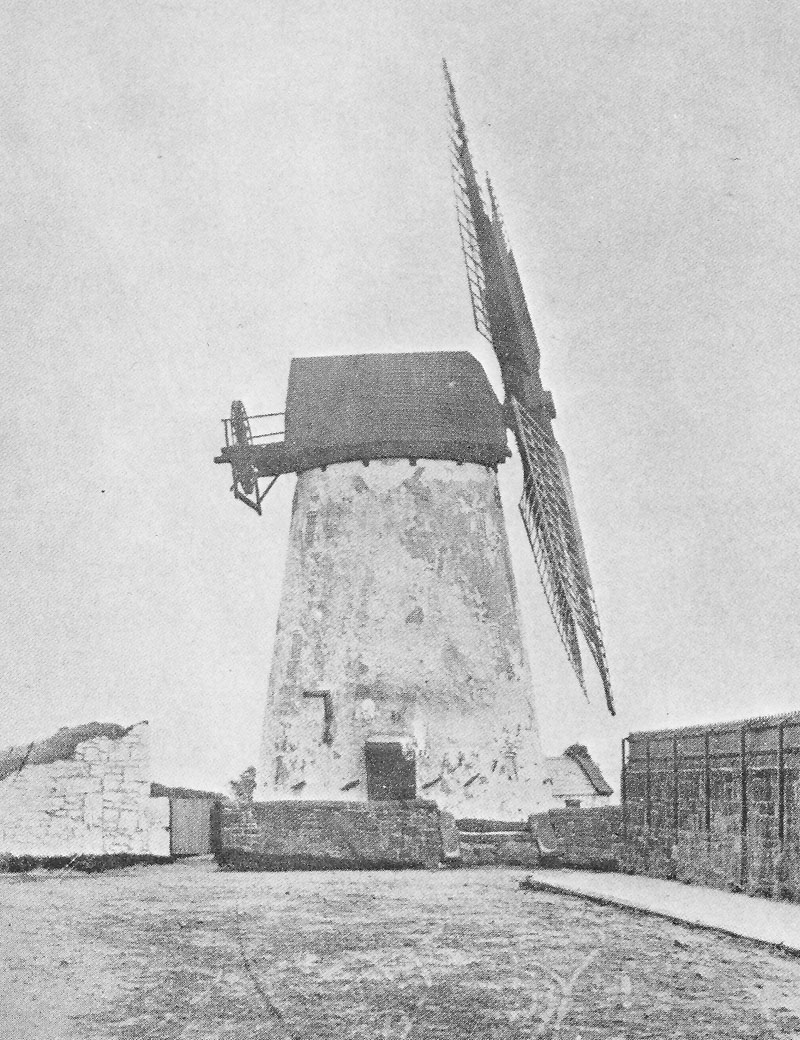 See Village 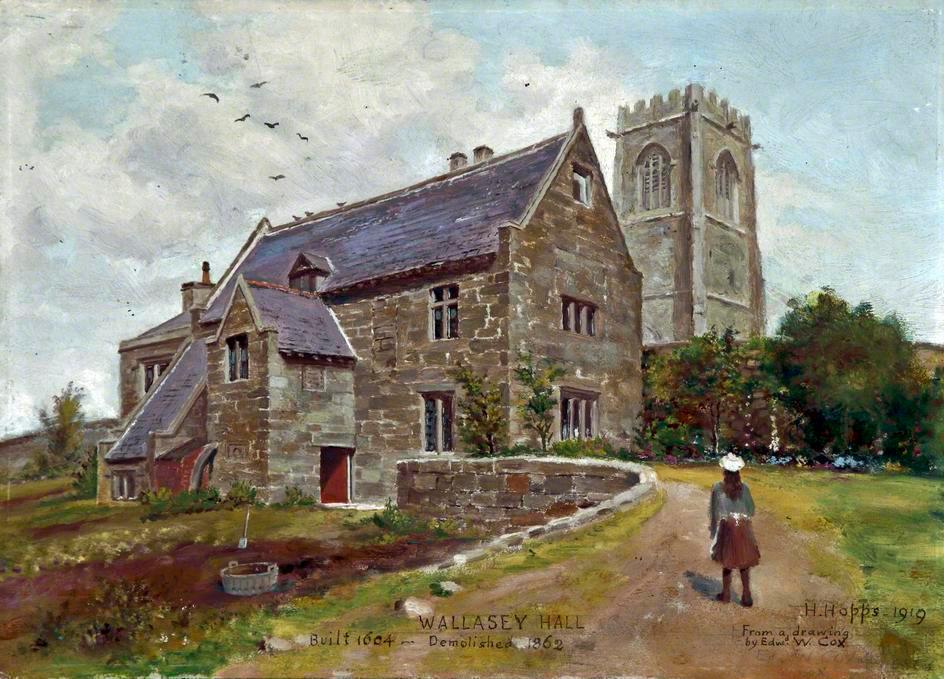 Wallasey Hall 1919 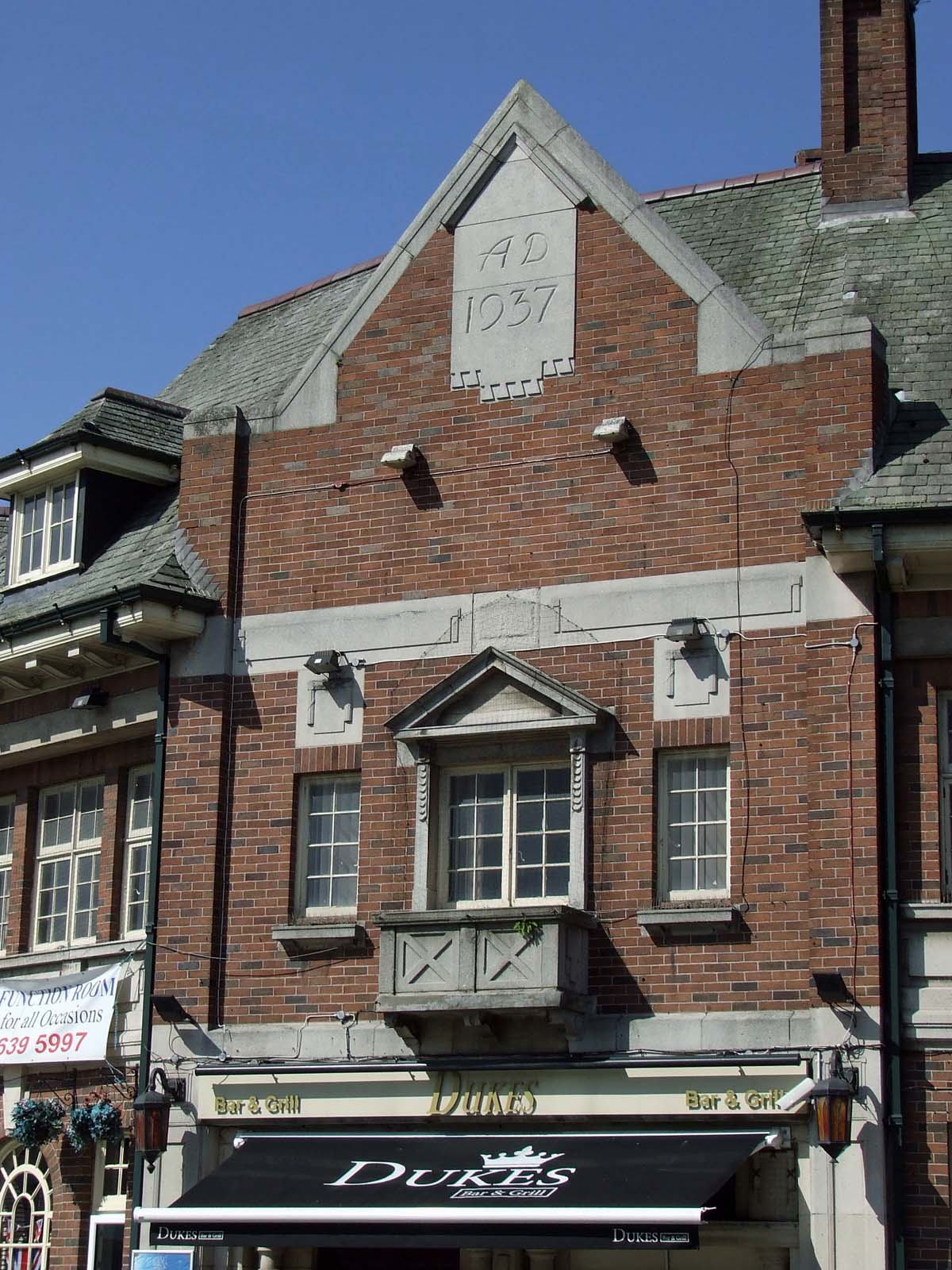 Liscard |
|
The earliest industry here on the northern tip would have been Milling. Poulton, or Rake Mill, stood in 1665. In 1765 a mill was built at the opposite end of the Breck, demolished in 1887. Liscard mill stood in 1819 but disappeared by 1841. Not yet in Wallasey, but Saughall had a mill on the borders with Moreton. Over the Moss, Bidston still displays here Mill and can be seen for miles around, it was recently re roofed (2005-6). On Wallaseys Dock Road, running alongside the Pool, I worked in the late 60s/early 70s in Paul's Mill, for Spillers and across the road was MacDougall's, which was destroyed by fire around 1970. Seacombe had the Seacombe Pottery, 6 kilns all in a row. This flourished up to 1873, when a shipwreck brought financial ruin, costing them dearly. Little remains of their fine products but a few examples can be seen today in the Williamson Art Gallery in Birkenhead. (Somewhere I have yet to visit) Seacombe also boasted a Sugar Works which existed on the dock road around 1860. Mawdsley's & Smith's Smalt works also existed on the dock road until the same year. Known to be in production before 1741. The making of smalt was of Saxon origin. Consisting of cobalt, potash and ground flint. When it was heated and dropped into cold water it shattered so finely it could be crushed into a powder for use in paintings and mixed with starch to produce coloured linens. Havelock Street has the Peruvian Guano Works, which commenced about 1830. I understand the "aroma" was quite becoming. Bibby & Co Copper works started in about 1812, standing near Creek Side until about 1863. Some of the workers cottages were still in existence up to 1959. If they are where I imagine them to be, they were still there in the early 70s. Grosvenor Brewery in borough Road, Seacombe acquired in 1896 by a Yorkshireman, John Cattle, its not known when it closed down. Spraggs Wallasey Vale Brewery on Leasowe Road dated back to 1856. A pottery stood on Green Lane in 1831. In 1751 gunpowder was stored at the Magazine. This was to avoid transporting it through the streets of Liverpool. Barker & Jones, brickworks, stood off Leasowe Road. It was still going strong when I lived there in the 1960s. They acquired the Moreton Works in 1930 and production then was 380,000 bricks per week. Seacombe Shipbuilding took place, chiefly between 1864 and 1887. Bowdler & Chaffer, 1864 - Andrews & Co, Thomas Vernon & Sons, Alexander Jack and JF Waddington followed. All had yards along the stretch of what is now Seacombe Ferry and the entrance to the docks. Everybody in Wallasey knew Gandy Belt. A very large factory on Wheatland Lane. A Belting & Brake Lining manufacturers. Started in 1863 by Captain Gandy, a seafarer from the days of the famous tea clippers. He transfered his works from Liverpool in 1891. In 1927 fire closed the factory for two years. I can recall this huge building of dark red brick very well indeed but have no idea what became of it. In the 60s it was thriving. I can remember looking through the grime covered windows at some "strange and dark, mysterious place beyond." Al Etherington tells me about Gandy's (Nov 08): .... well I worked there from 1958 till leaving for Canada in 1965, I met my wife there, she was a weaver and I work on various jobs in the brake lining part of the factory. We came home for a holiday in 1969 and it was still there, but on another trip in 2002 it was gone, it was cut up into about 6-8 small business's, so not much of the old large building left. Coming toward the dock road from what is now the M53, the large tanks of United Molasses attract the eye at the Poulton end of the dock road. Further along we arrive at Stone Manganese Bronze, still there now. Formed in 1882, they made huge ships propellers. Originally based in London, they moved to Wallasey with the coming of WW2. A wise move indeed! |
1970 onwards In August 1970 signals began to appear near the docklands indicating to motorists the current bridge state, which was open, which was closed. This was a positive beneficial idea, allowing motorists time to decide on a diversion is necessary. not to mention emergency vehicles. In all there were a total of 7 signals. Shame they cant put pre warning signs on motorways! In 1971 the population of Wallasey was 97,040 compared with 103,209 in 1961. Many emigrated during this period, whole families shipped out to Australia and New Zealand and, to a lesser extent, Canada. Others like myself left for the Forces, severing my ties, and eventually taking my new family with me to Germany and beyond. In June 1971, a 36 inch 3 mile pipe was laid out into the Irish Sea to dump sewage directly into the sea to "facilitate" yet more homes being built on land long left to nature. I noted that, on a visit to the sea in 1974, my legs "tingled" when I was in the water paddling. I never went into that sea again, ever. Work began on a second Mersey Tunnel, entrance by Gorsey Lane, Wallasey and from the new M53 which split Fender Valley and Wirral right down the middle to south of Chester. The motorway followed the route of the old Seacombe railway line. The tunnel opened to traffic in June 1971 and the M53 in February 1972. The M53 crosses Bidston Moss and piles had to be driven down 70 meters, the deepest piles in Europe at that time. (says it all really!!). New access roads were built upon the Moss which now sports industrial units, supermarkets and megastores. As a Borough, Wallasey died on 1st April 1974. Much to the annoyance of much of the population, Wallasey became part of the Merseyside County Council which included the detachment of Wirral from Cheshire, a link we were all proud of and, instead, "dumped" with Liverpool. Also parts of Lancashire suddenly found themselves now Merseyside. It was not popular then, and this has not waned over the years since. I was talking to a noted historian on the Wirral, via my computer, and he said that I had Wirral in a Merseyside folder on my site. He said "and you can damn well change that! We are NOT Merseyside!" I did. Looking Back Looking back, it was the best time to be a Merseysider, but also the worst 'the best of times, the worst of times'. It was the era when many old irreplaceable buildings and sites were ripped down and "modern" plastic, steel and glass replaced them. High rise flats sprang up, like mushrooms in the night and small villages were suddenly suburbs. a testimony to the quick building, poor materials, get rich fad of the 1960s was that many of these are now, in turn, being torn down and replaced by buildings, in some cases, more pleasing to the eye. I suppose Wallasey should consider itself lucky in that many of the Victorian and Edwardian buildings that cover Wallasey are much prized dwellings as well as places of learning and commerce. Who can forget the grand old ABC Cinema in Liscard. Not a cinema for many a year but still there. The worst area of Wallasey to change, sorry to say, is my home town of Moreton. Leasowe, although post war, has managed to retain much of its original facade but Moreton is a pale ghost of itself, choked with people and traffic. "Plazzy" shops and sun tan parlours and fast foot eateries! Those of you too young to recall "ye olde Wirral" should take a trip and sit by Raby Mere no matter the weather. A trip back in time. But be mindful of the young idiotic kids in their flash looking wrecks with a stereo that costs much more than the car! In March 2010 I had occasion to be parked outside The Plough in Moreton, god, what a dump, it is now magnificent in its decay. 2011 now gone, its a supermarket. |
Liverpool Mercury
|
|
|
Monument
A monument commemorating those who lost their lives was erected in Rake Lane Cemetery. The inscription reads: This memorial is erected to honour the 324. non-combatant residents of Wallasey of whom 51 rest here who lost their lives by air attack from the enemy during the Second Great War, 1938-1945. In Wallasey, as a largely residential town, houses and people bore the main weight of the attacks. In addition to the killed, 275 were seriously injured and more than 600 less seriously. Houses totally destroyed numbered 1,150, and 17,000 were damaged; in fact, it would have been difficult to find a house in the older part of the town that had escaped damage entirely. There were 500 alerts, and 658 high explosive bombs, including 17 parachute mines, are known to have fallen on the town, together with thousands of incendiaries. Blitz
|
Wallasey Road Names & their Meanings Poulton Road -
led to Poulton at the head of the Pool. Other Wallasey names are also associated with roads including Maddock, Penkett, Steel, Walmsley and Tobin. |
The World's First Solar Powered Building On Leasowe Road is the first building in the world to be heated entirely by solar energy. St Georges School was built in 1961 to the designs of Emslie Morgan, a genius who spent a lifetime looking into ways of harnessing the suns rays. His research resulted in the Solar School, a matchbox like building with, on one side a drab, windowless facade and on the other I0,000 square feet of glass, a giant solar wall. The wall is built of glass leaves two feet apart. These draw the ultra violet rays from sunshine and bounce them around the walls of the classrooms. The walls become warm and heat the air. Hardly any warmth escapes through the schools massively thick roof and walls covered with slabs of plastic foam. On the coldest days it is always 60 degrees Fahrenheit inside, and in summer the school is cooler than its more conventional neighbours, for panels inside the glass wall can be turned to deflect heat or absorb it. It need hardly be said that, despite the uniqueness of the building at the time of its erection, it was left to foreign designers to take up the invention and use it on a world wide scale. From the book Portrait of Wirral by Kenneth Burnley 1981. |
As a young man in
Moreton, I would visit the library and sign out The Rise & Progress of Wallasey
in order to read up on various aspects of Wallasey history. I would refer to it
as The Rise & Fall Of Wallasey, after the Rise & Fall of The Roman Empire film.
It was quite prophetic really as, in my opinion, Wallasey has done just that,
fallen. There is much that has worsened. When I visit it looks worse each time, shuttered shops, littered streets and, on Jan 26th 2006, the news that the Museum on the Docks is to go to make way for greed and money in the form of so called "luxury" apartments. This has happened and the museum has gone. Luckily, the U Boat (U534) has been saved and now resides at Woodside Ferry Bhead in its own display centre. Our heritage is blighted by the developer. Socialism took over from the traditional Tory seat in both Council and Parliament and I believe Wallasey has never recovered. I have finally purchased my own copy of this book, reprinted with an additional chapter from my original 1960 library copy, in 1974. |
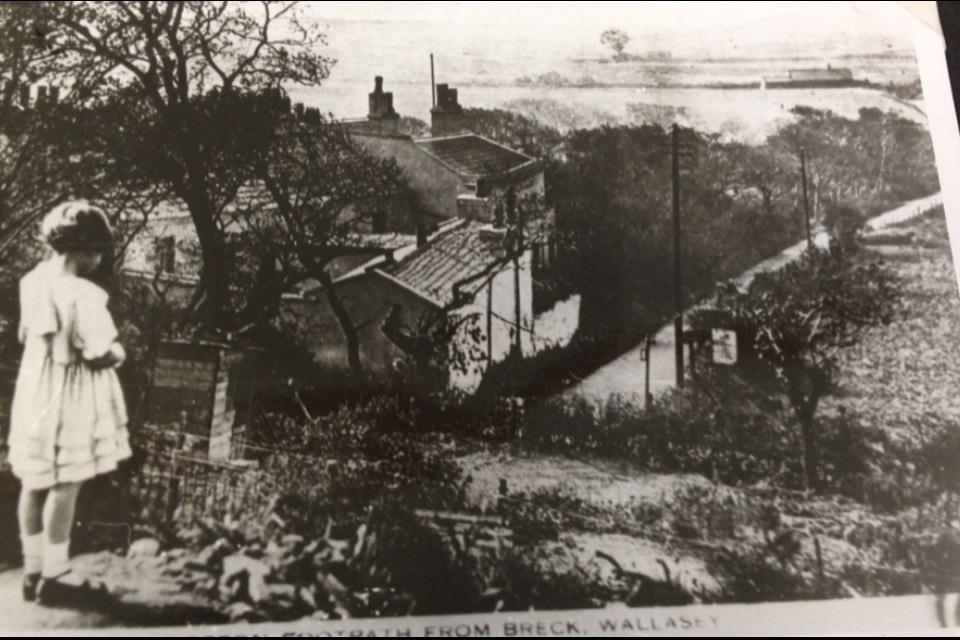 Breck |
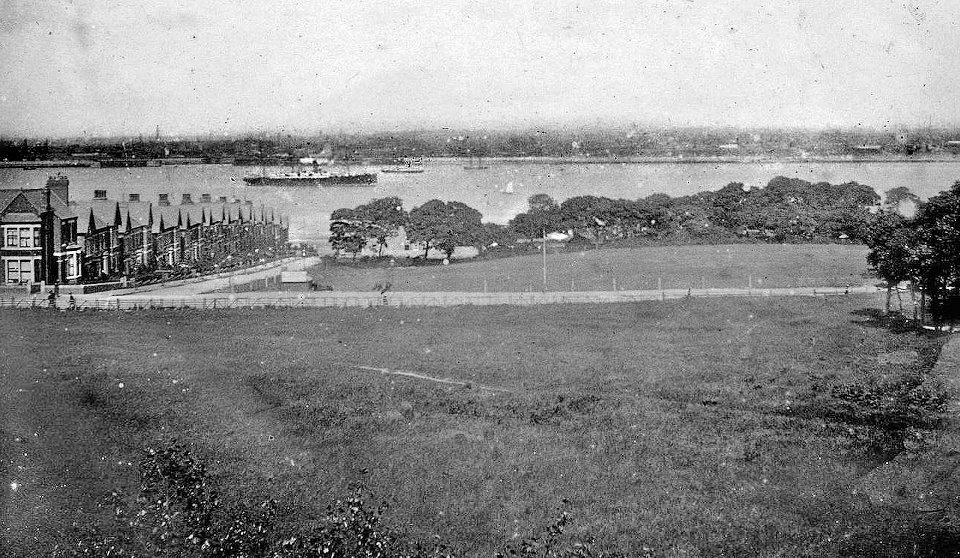 Caithness Drive |
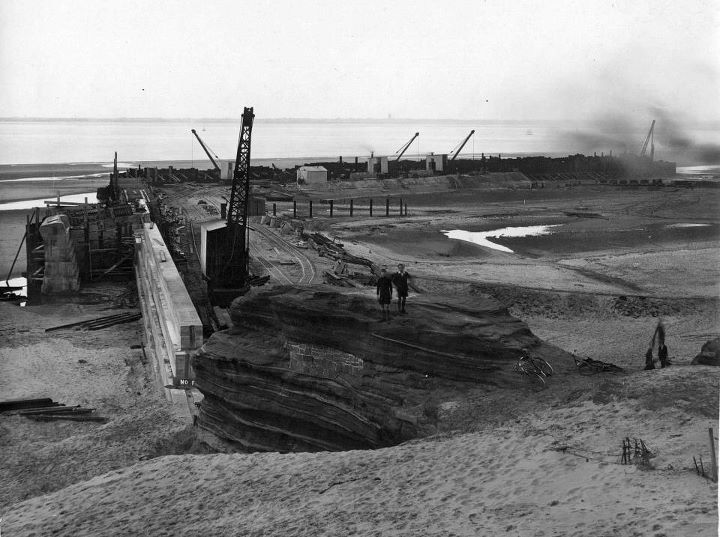 Building the embankment New Brighton |
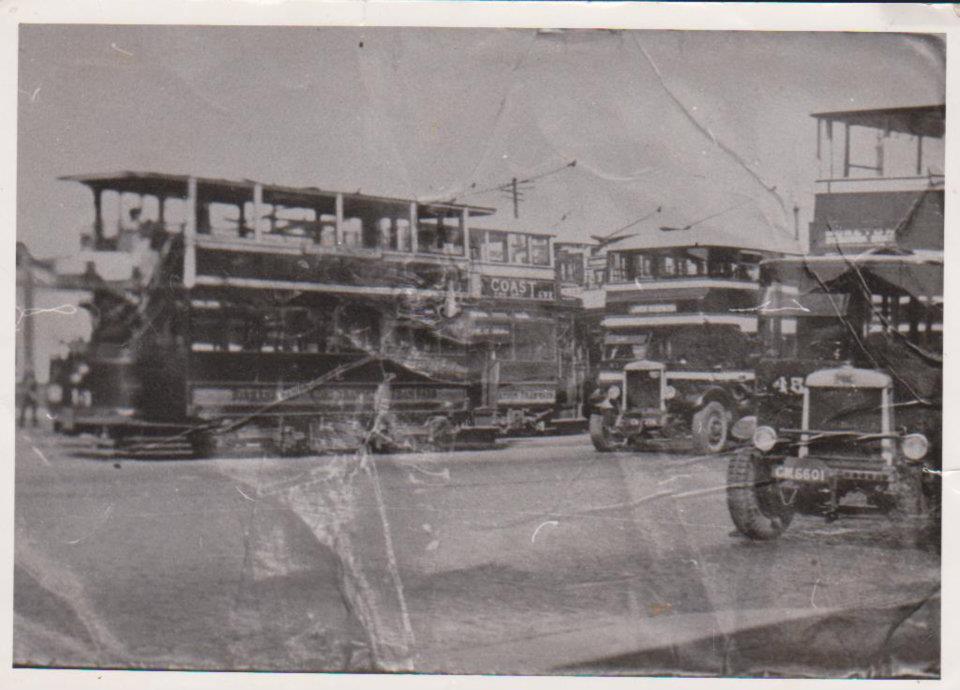 Trams and Omnibus |
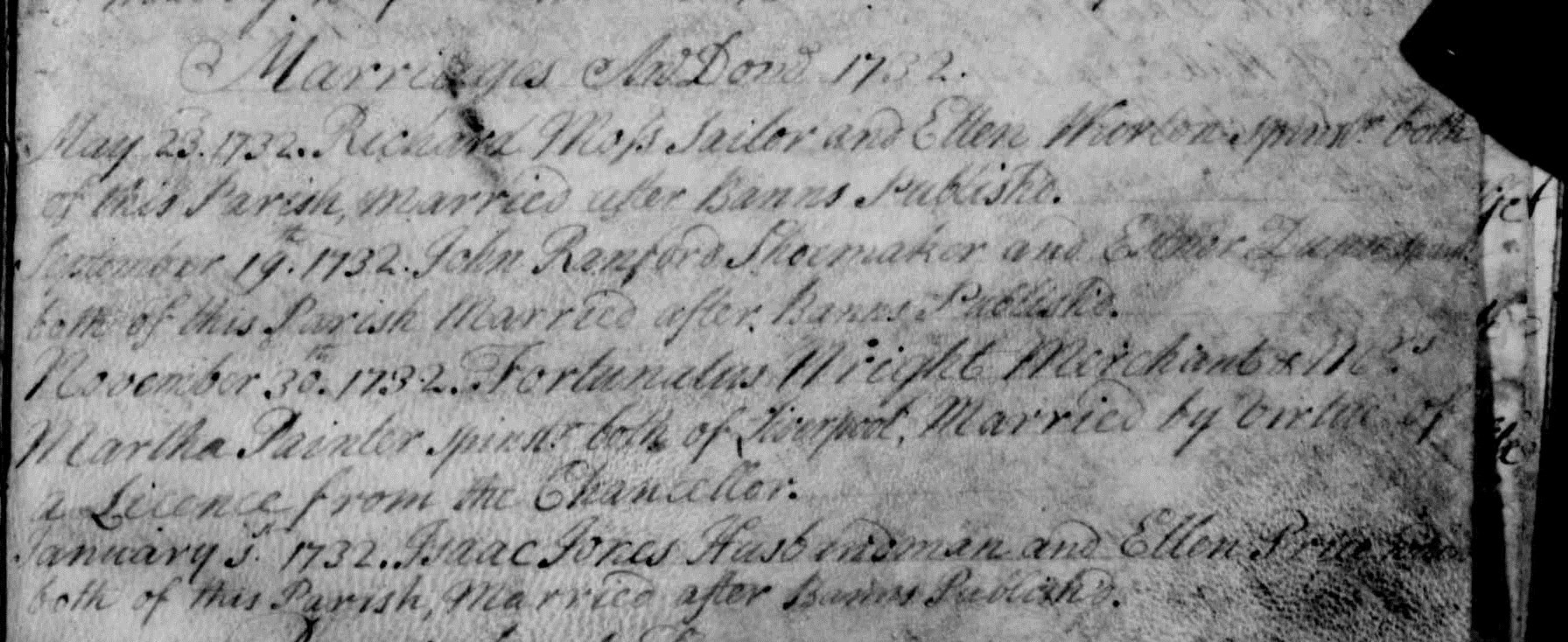 The wedding certificate of Fortunatus Wright, Wallasey Pirate & Privateer |
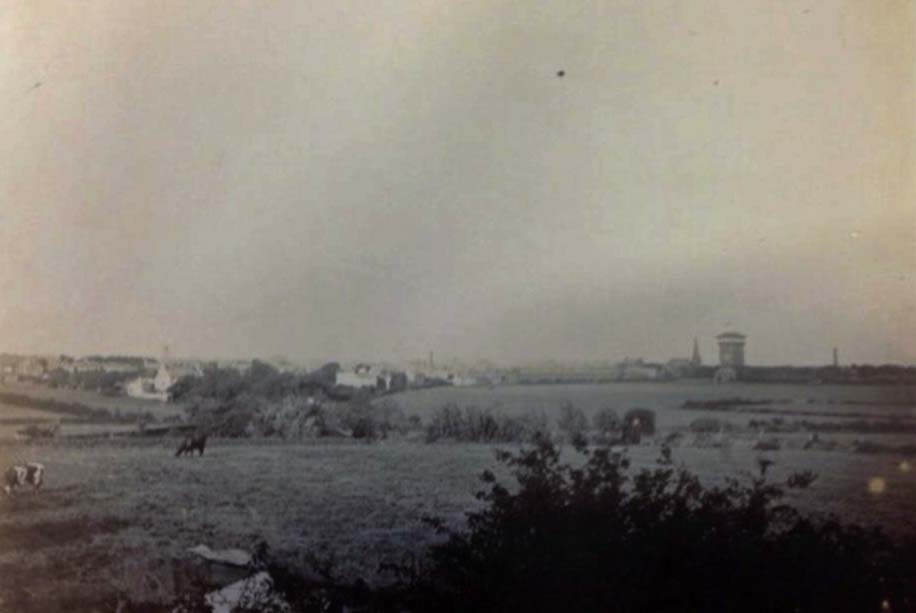 Water Tower in Liscard |
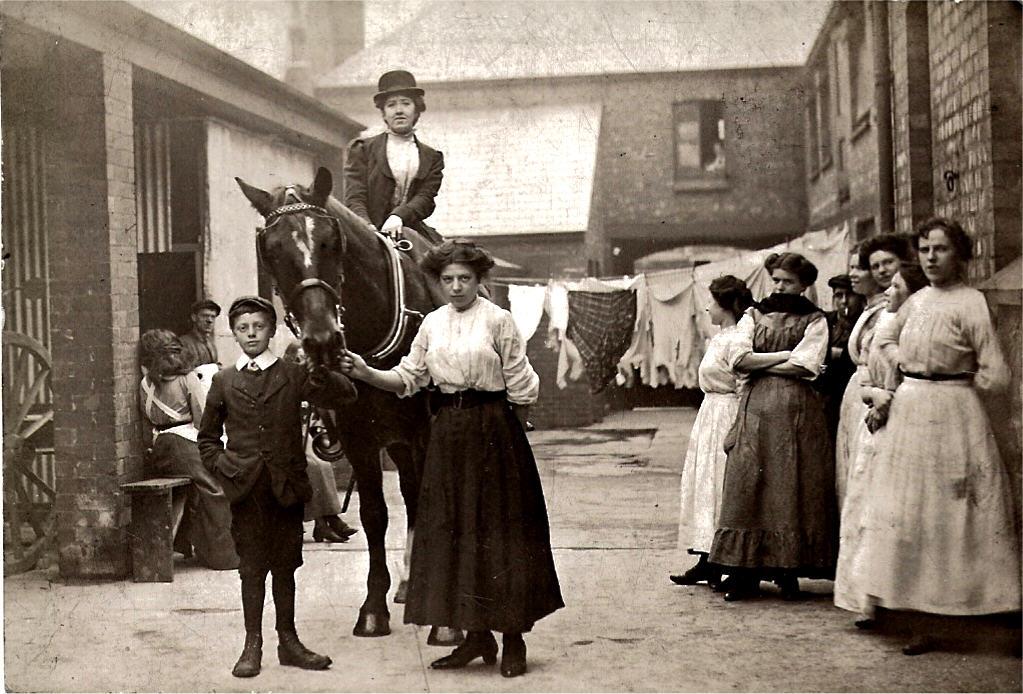 I think the story behind this image is of a bit of fun. A lady sent in her riding clothes to this Wallasey Laundry and the young lady put them on, and posed on the laundry's horse! Images that show life as it was are invaluable, and my favourites |
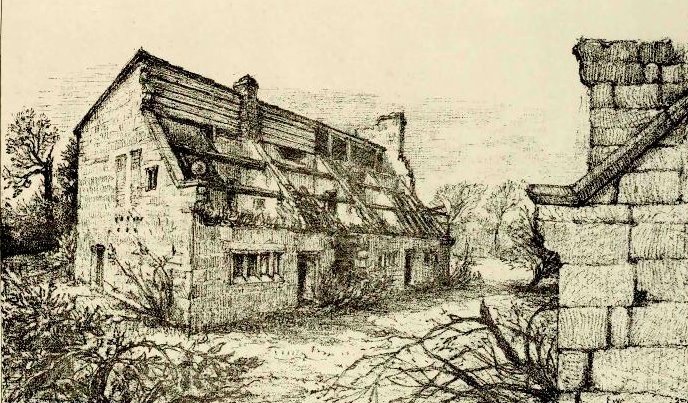 Horse Racing Stables - See Racing |
 Wallasey Bakery |
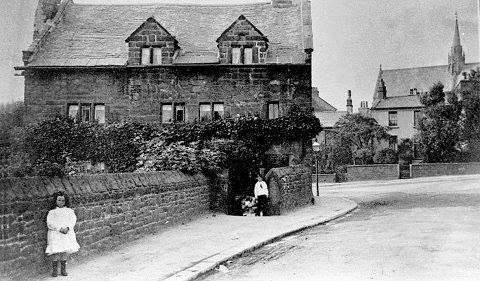 Bird House |
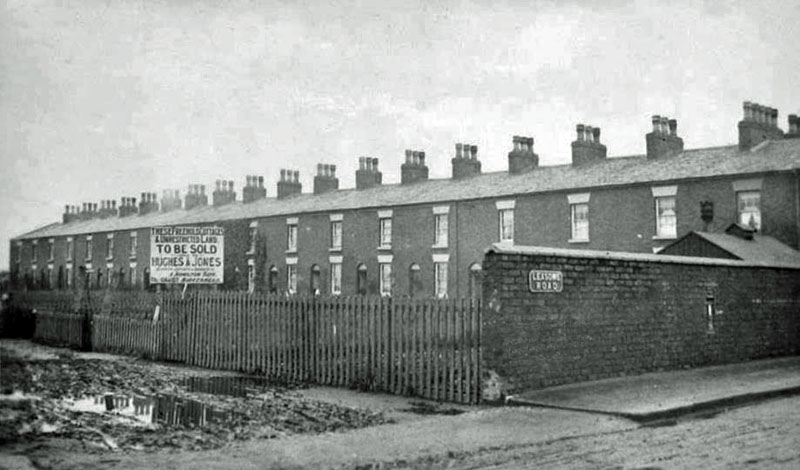 Twenty Row |
|
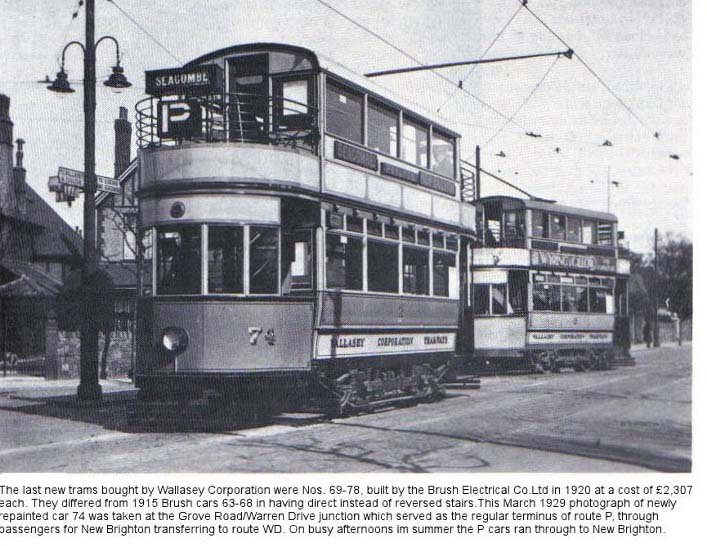 |
|
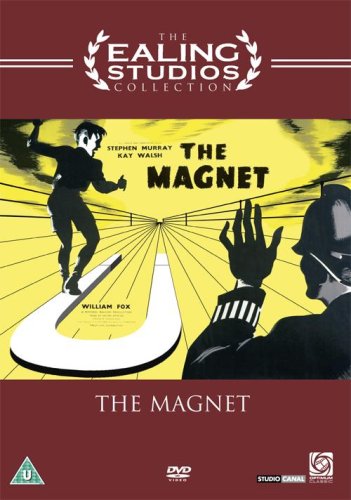 Filmed in Wallasey 1950. Available on dvd via amazon. Extract from Wallasey Fire Bde history (below): When the Ealing Studio film crew came to make "The Magnet" in Wallasey, the director, Charles Frend came to the Wallasey Fire Brigade and asked for help. Three Firemen were chosen to play a small part in the film, namely Ted Jones, Johnny Ellison and Bill Forber. A Liverpool Policeman was also asked to take part in a scene which involved the Wallasey Firemen. |
|
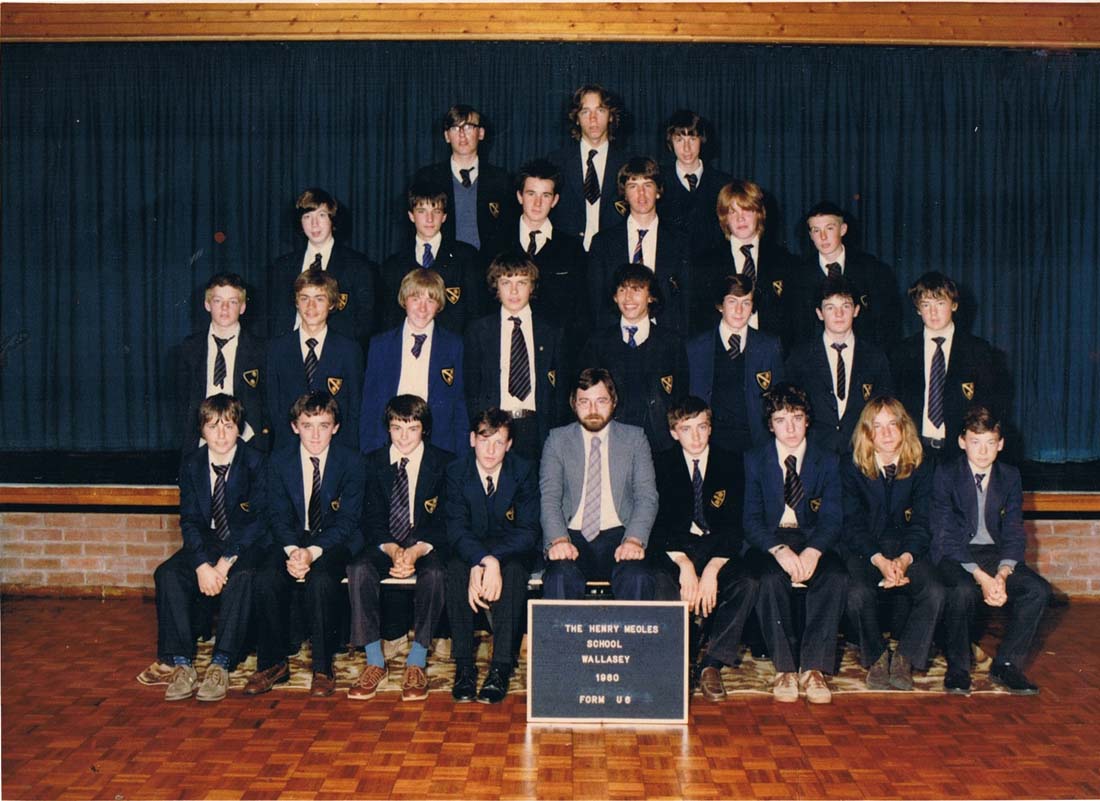 Henry Meoles School 1980 (From Kevin Tunstall in NZ) |
|
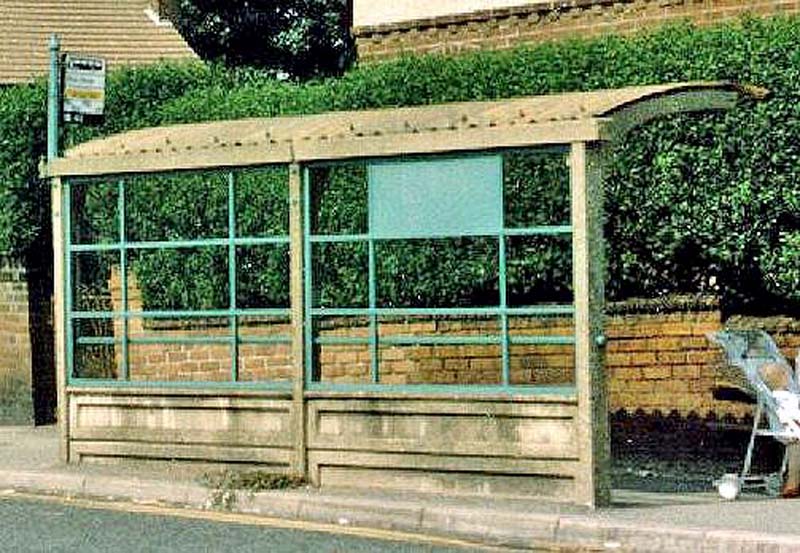 Remember the old bus stops? |
|
 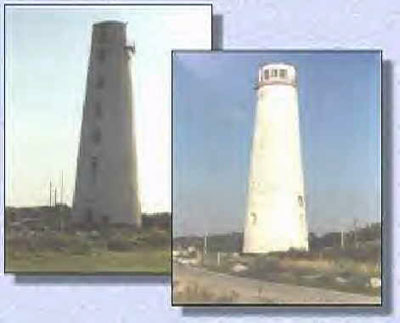 From the book Images of Wirral by Kenneth Burnley & Guy Huntingdon ISBN 0 9517961 0 0. Reproduced by permission Kenneth Burnley as is the image of Leasowe Lighthouse |
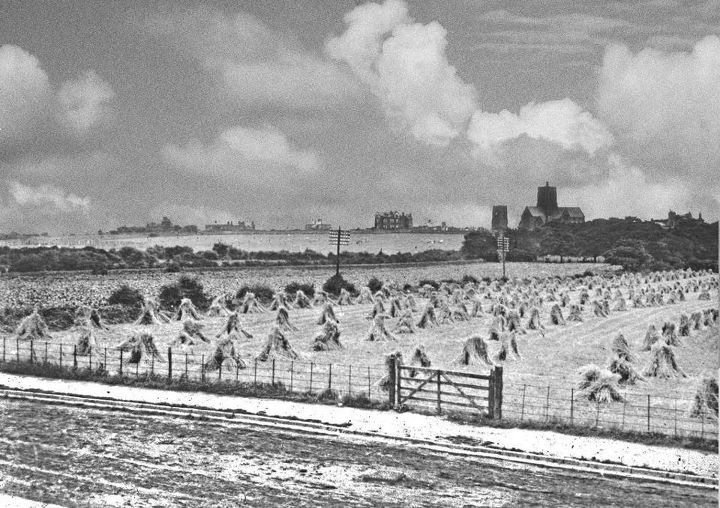 See also Village |
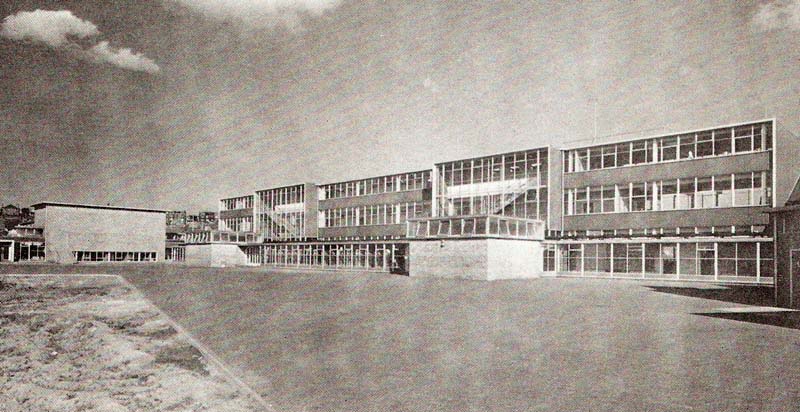 Technical Grammar School |
 |
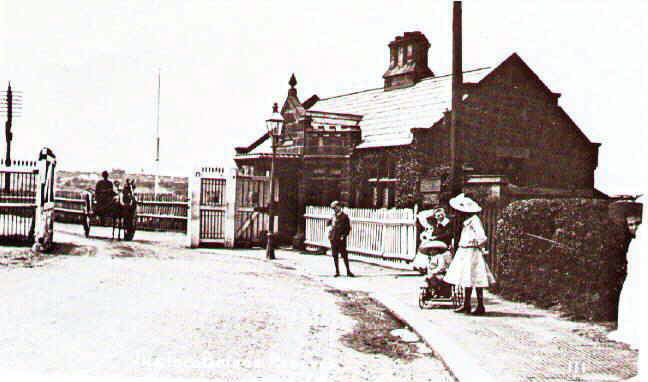 |
Left:
Penny Bridge, Leading to Birkenhead Half Penny bridge began in 1843, so called because of the half penny toll to cross it. It was situated in Wallasey Pool on the road between Bidston and Poulton. Made of wood and it opened in the middle to allow ships to pass through. On 1st September 1896 the fare was increased to one penny, the bridge is still known as penny bridge to this day. In 1926 it was replaced by a modern swing bridge by the Mersey Docks & Harbour Board. The reason for the bridge vanishing, in the late 20th Century, was the filling in of Bidston Dock. Seacombe |
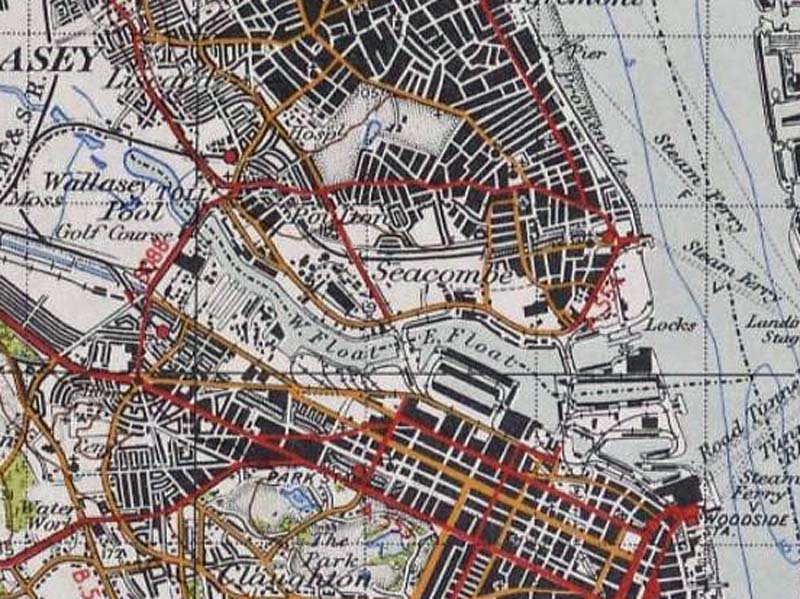 Central Park Liscard can be clearly seen as can Poulton Station, and Seacombe station (which I can remember). Penny Bridge (toll) crosses Wallasey Pool, these are the docks on the Wirral side of the river Mersey, note the Mersey Tunnel which was already in use. Woodside Station which I also recall in the 60s and the steam trains. Bottom Centre is Birkenhead Park on which Central Park New York was modelled. |
|
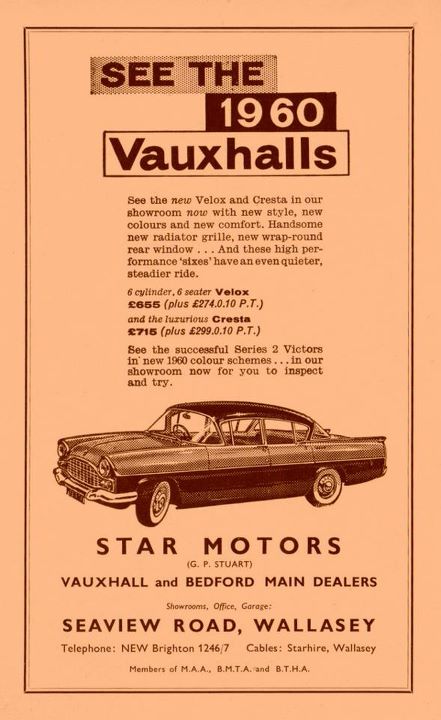 |
|
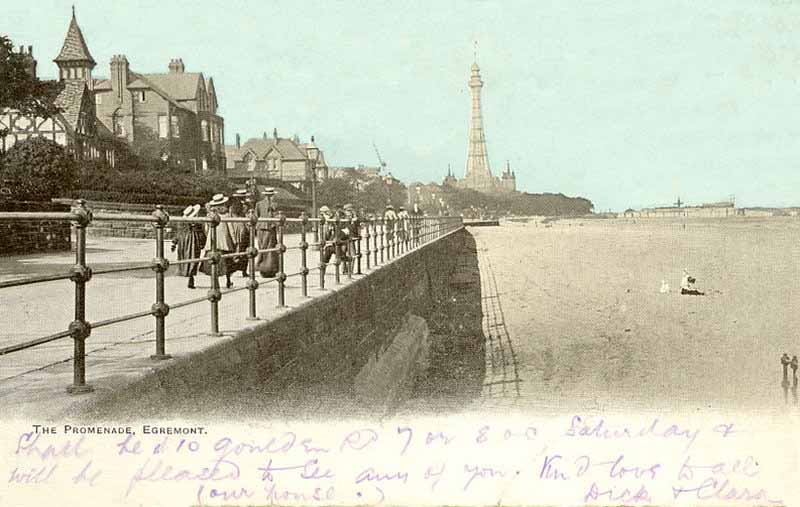 Mother Redcaps is the black & white building on the left. It was at this time a cafe I believe. See also my page on Mother Redcap's HERE |
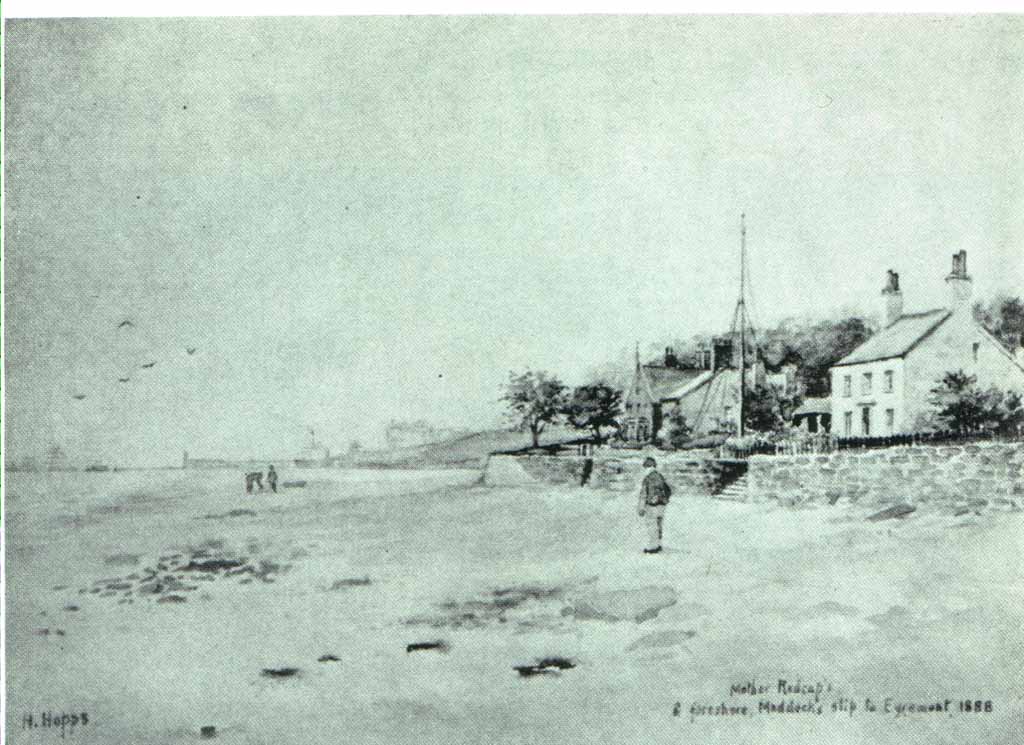 Mother Redcap's about 1888. I can recall this building as a youngster in the 1960s. Sadly demolished and a Nursing Home was built on the site. My mother died there in 1999, which is why it is so very poignant for me. Liverpool is on the extreme left of the painting. Seacombe Ferry behind the images on the sands. |
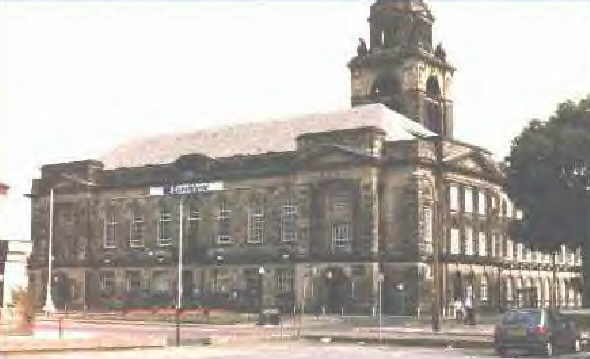 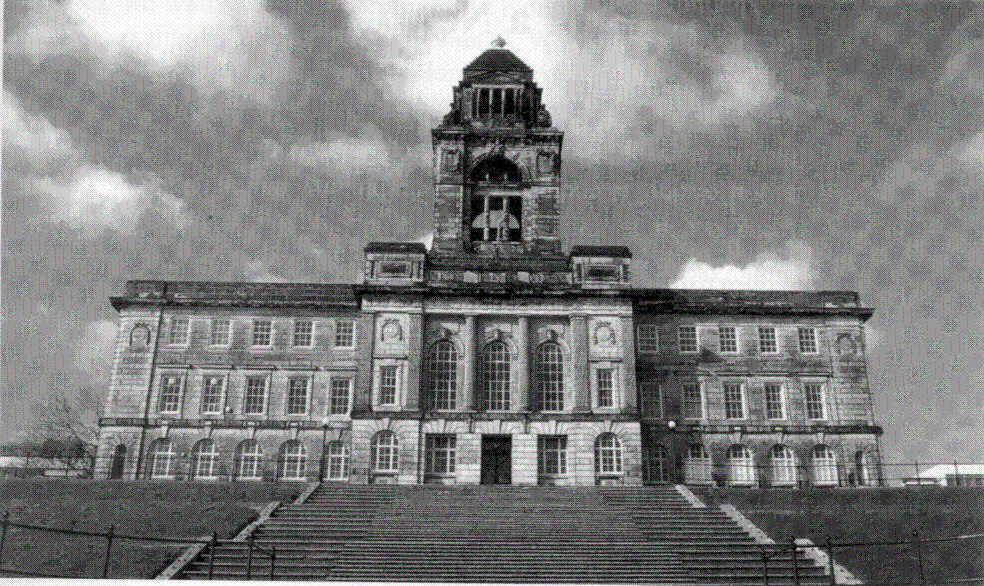 Wallasey Town Hall - landside (top) - and river side The Town Hall is actually in Egremont but many think it is in Seacombe. |
|
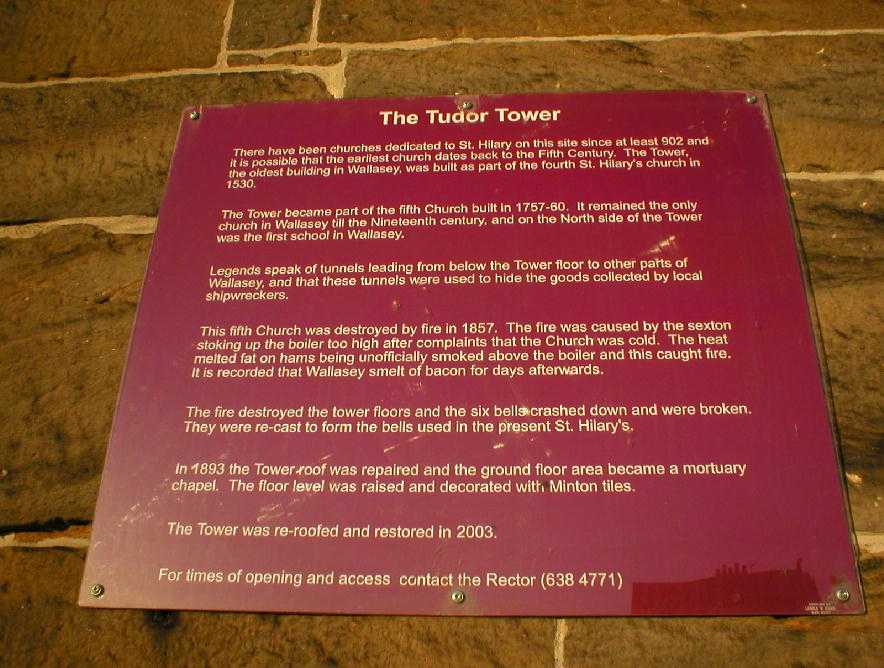 |
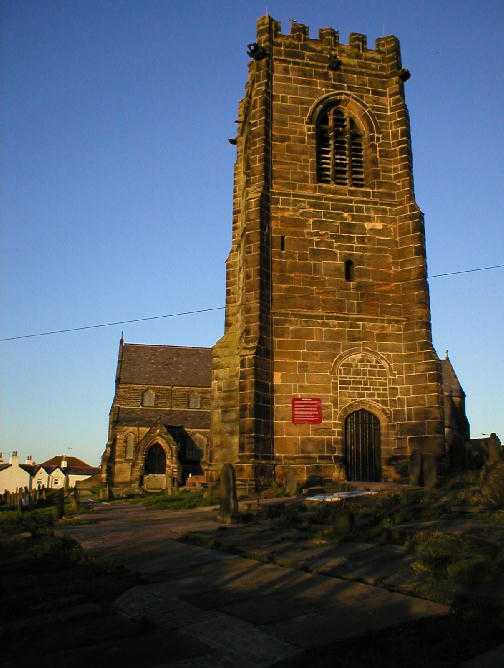 |
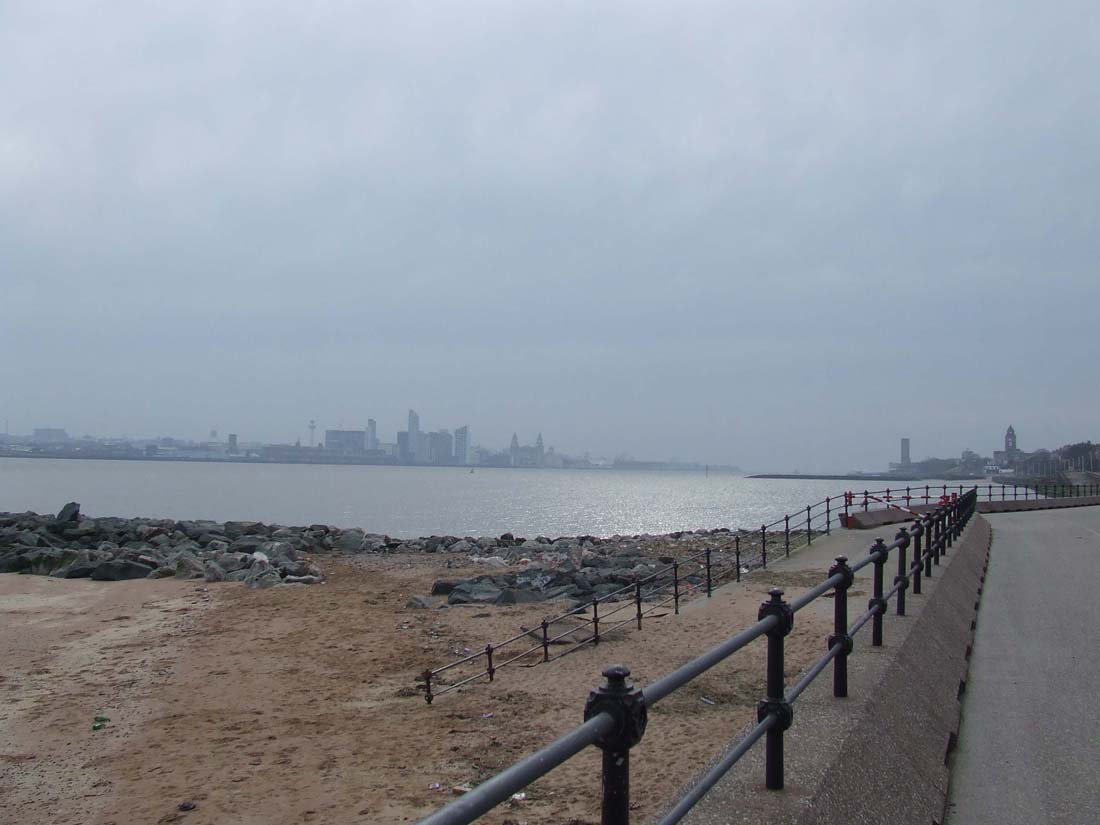 Egremont March 18th 2010 - The river is dead, not a thing moving |
Next: January 29th 2011 - Sunset over the Sands. Taken from the CC Station, Harrison Drive |
|
|
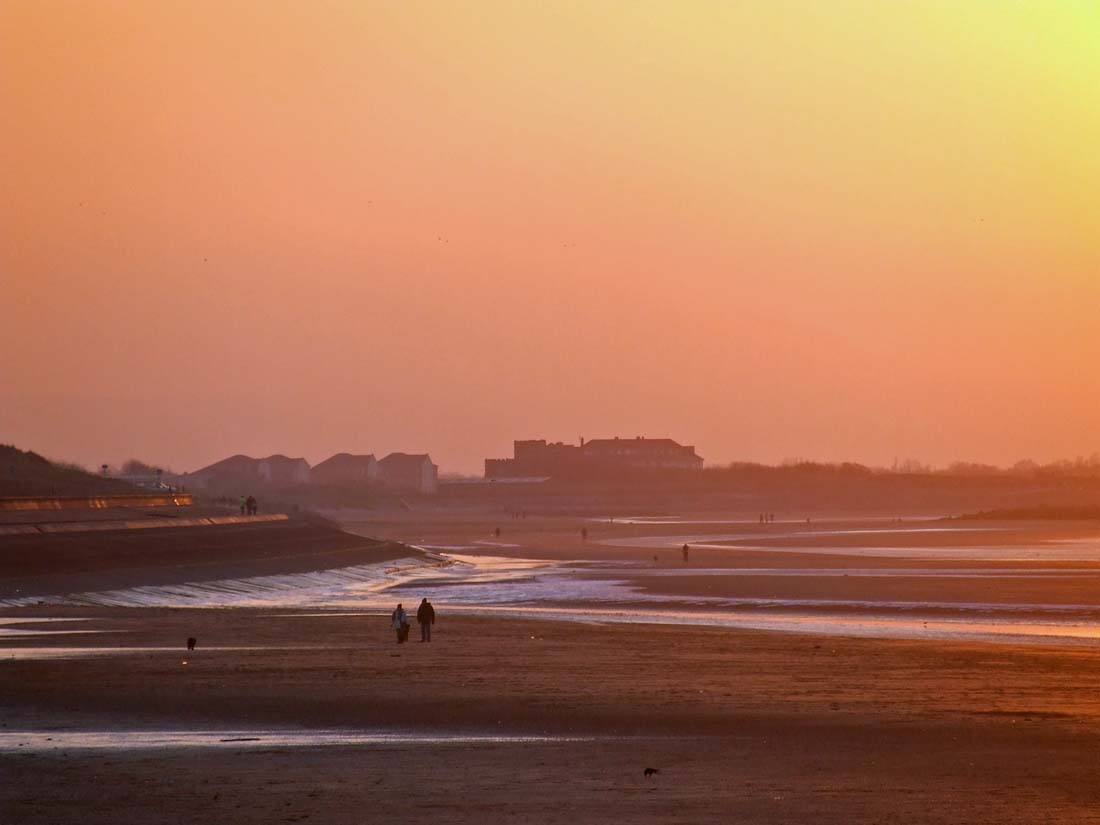 |
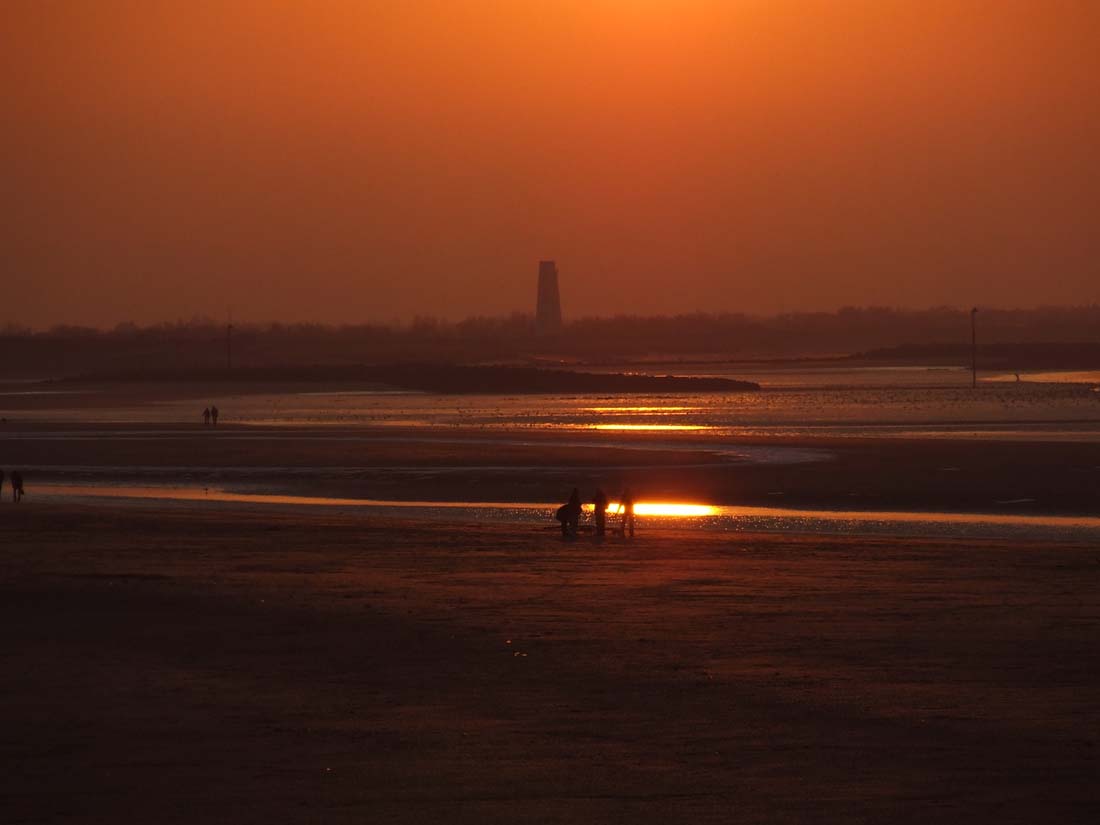 |
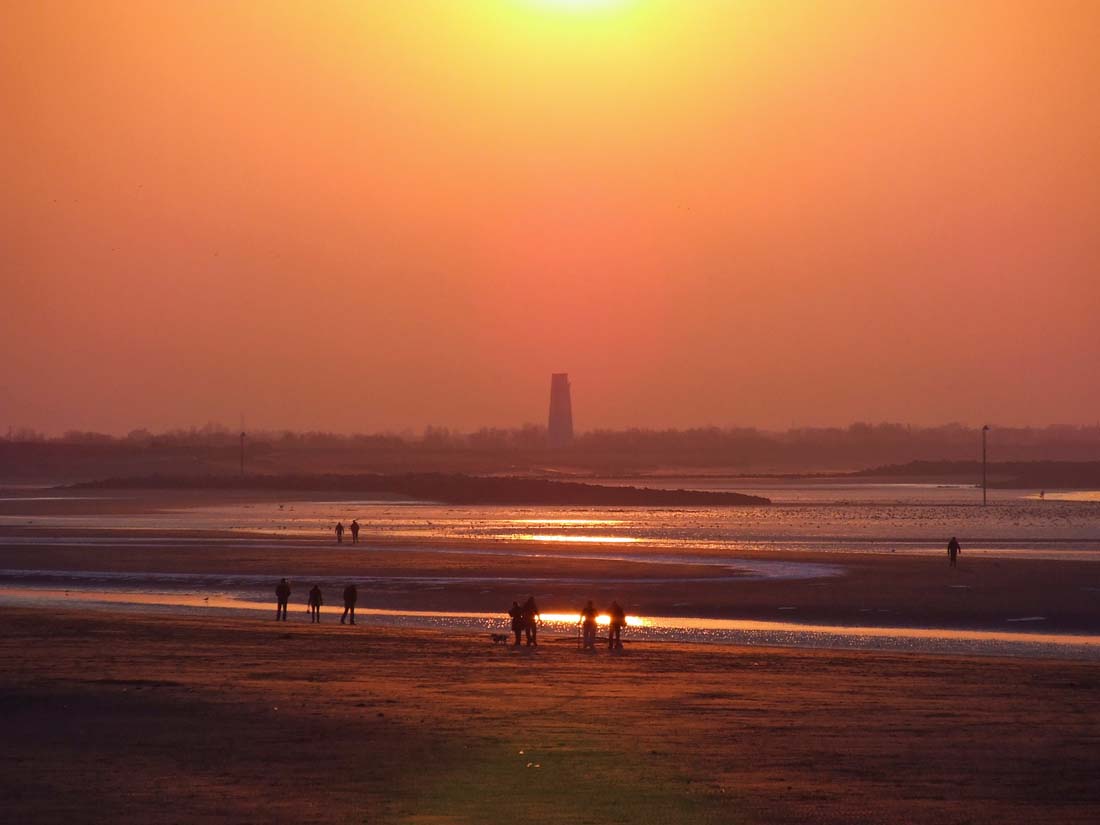 |
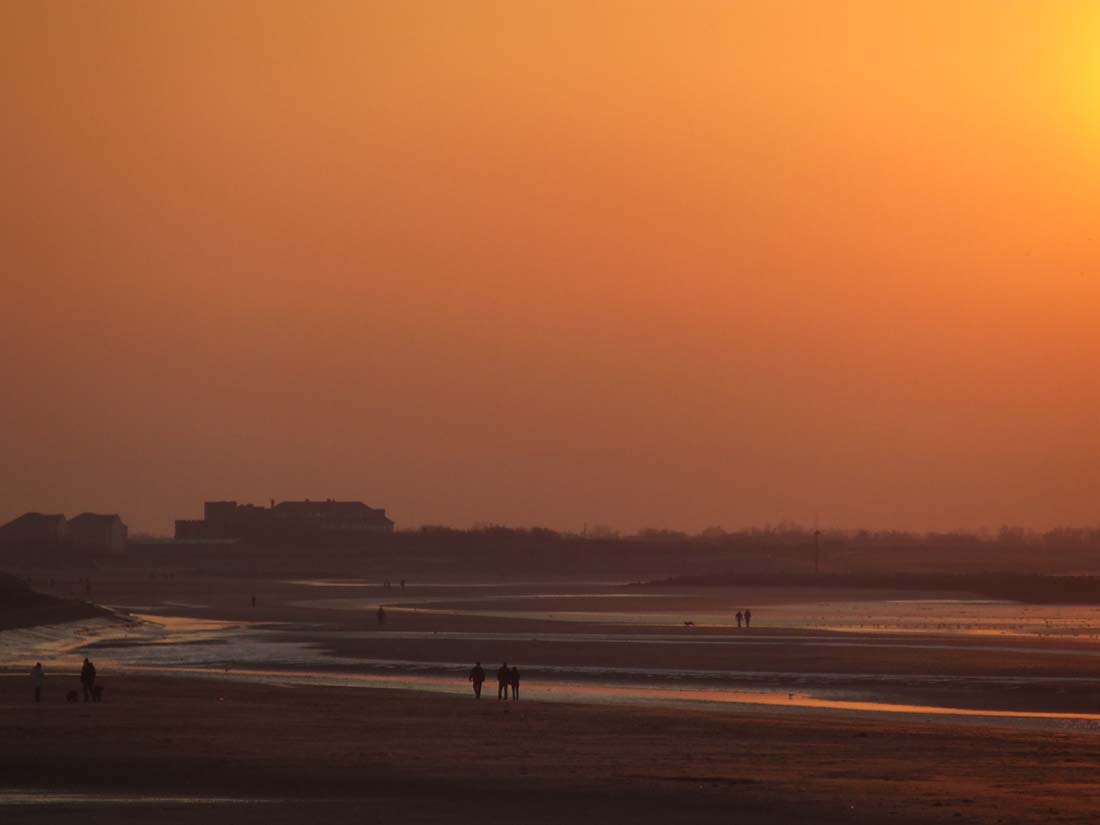 |
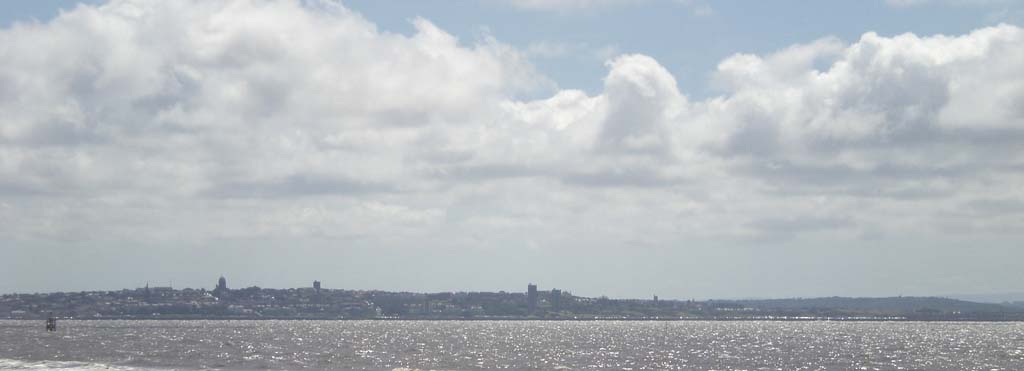 From a different perspective, Wallasey from out "at sea". Taken from the beach at Little Crosby - July 21st 2008 on the occasion of the Tall Ships visit. |
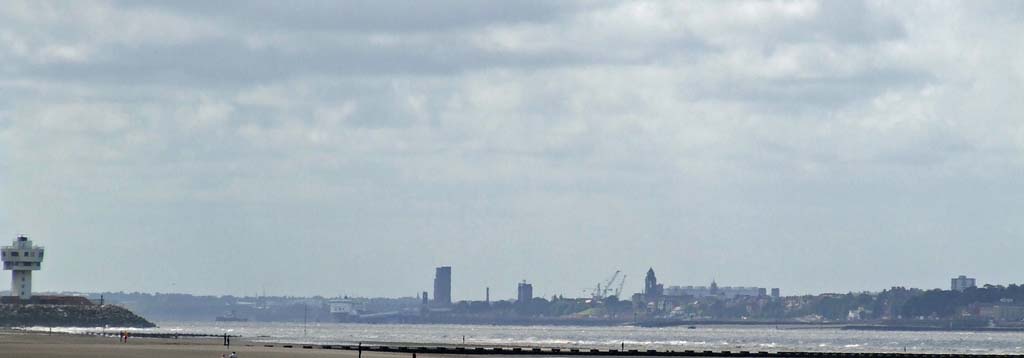 Looking into the Mersey Clearly visible is Wallasey Town Hall on the right centre. |
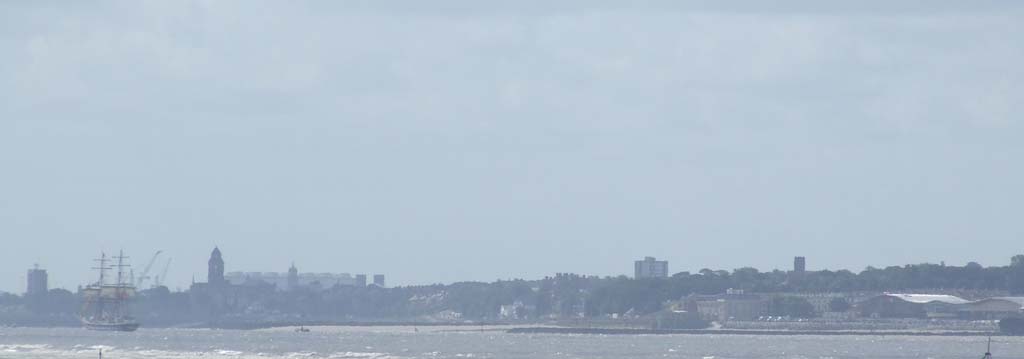 Tall Ship passing New Brighton - July 21st 2008 |
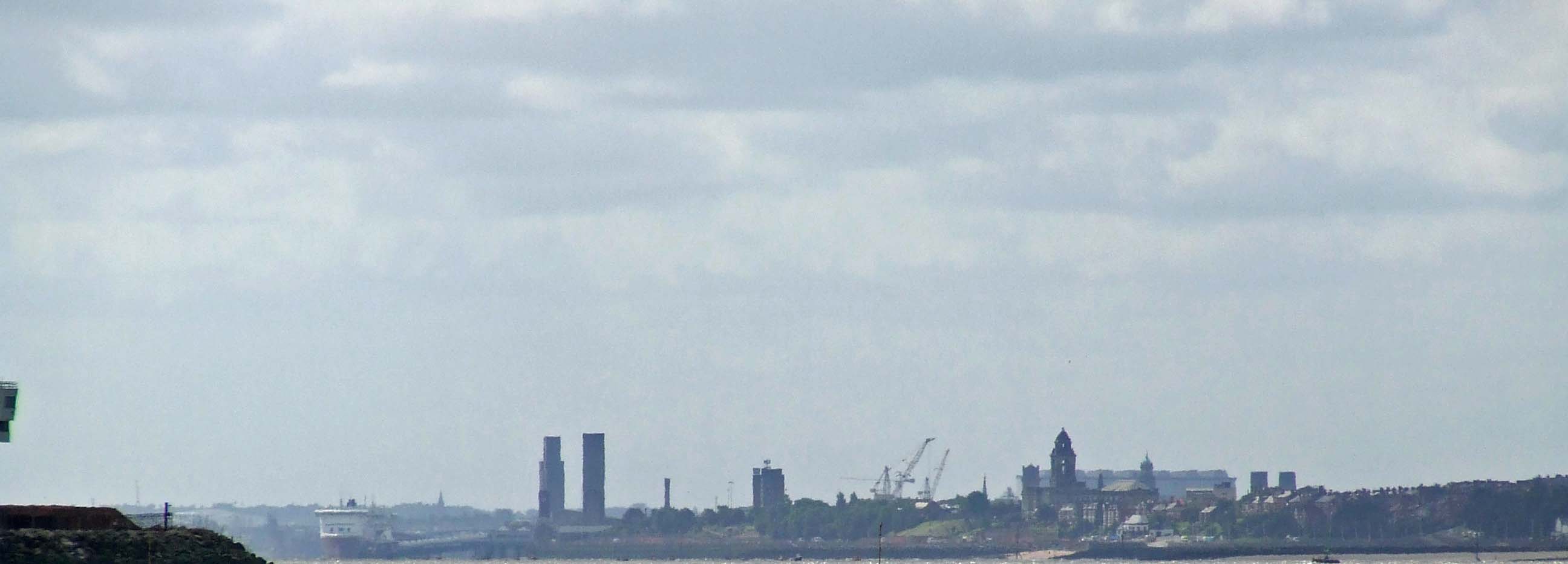 The ship at the Tranmere Oil Terminal looks like its tied up at Seacombe! |
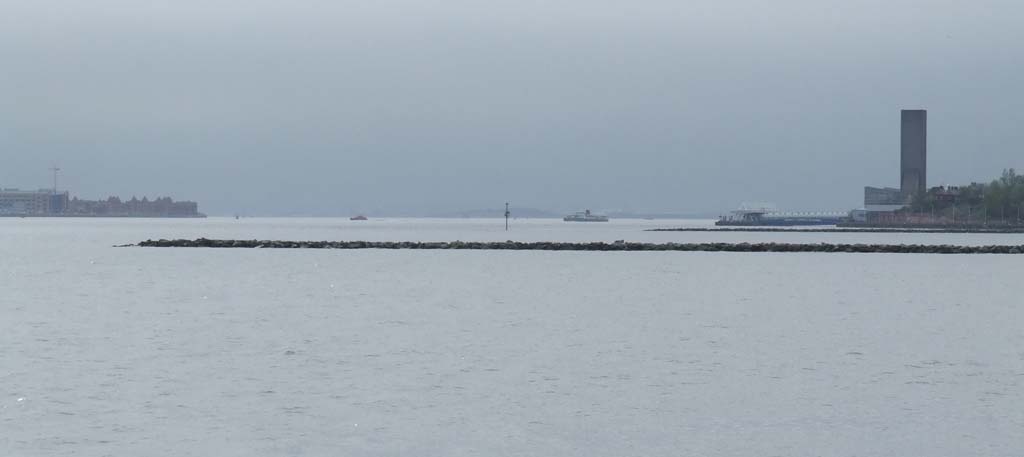 Looking toward Seacombe from New Brighton, lonely ferry! |
|
I took the above from across the river on Liverpool's Dock Road - May 29th 2008 |
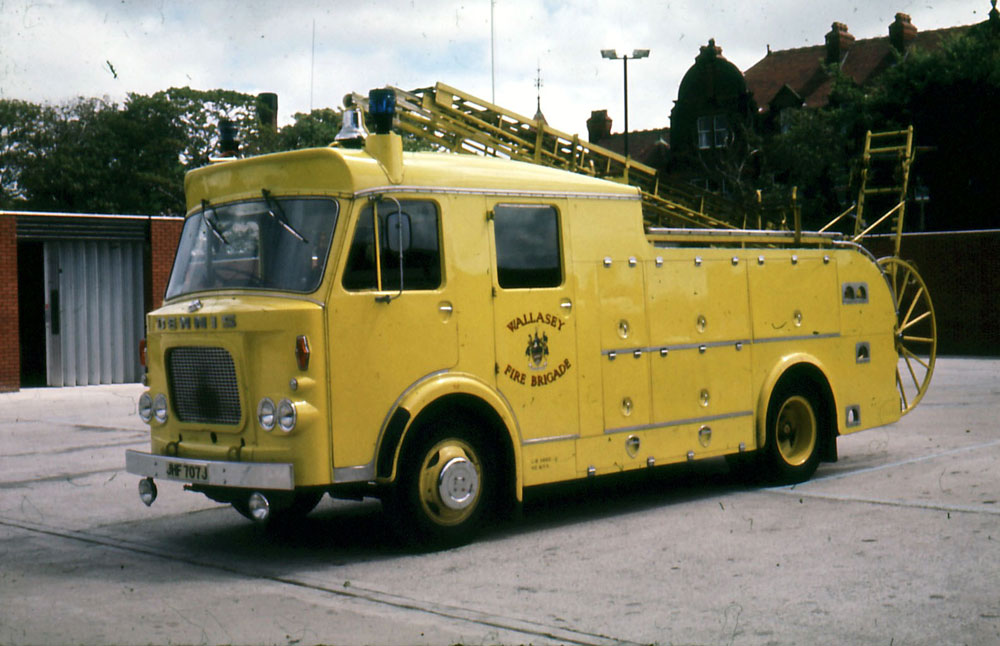 Dennis F43 Pump Escape JHF 707J |
|
Extracts
from The Story of The Wallasey Fire Brigade Written by © Noel E Smith of Rake Lane Wallasey and reproduced with his permission Also my thanks to the 'Museum of Police in Cheshire' (John Howard) at: http://www.museumofpolicingincheshire.org.uk/ for his kind assistance Printed by: Printfine Ltd Gibraltar Row Liverpool L3 7HJ Tel: 0151 242 0000 Website: www.printfine.co.uk ISBN: 0-9517762-4-X I Price £6.95 The extracts below are but a small part of the booklet |
|
| No one knows when the first firefighting force
was set up in Wallasey. In all probability, a small group of villagers
had access to a number of buckets and perhaps a hand cart to carry a
ladder. Maybe a bell was rung to summon the party and they would hurry
to the fire. Other people, no doubt, would gather and form a human chain
and the water-filled buckets would be passed along the line. All the men
were volunteers. The earliest record of a Fire Brigade in the town was
c. 1858. There used to be a large three-storey house at the foot of Magazine Lane, built in the early 1800s which, by the 1840s was the Liscard Hotel, later to become the New Brighton Hotel then the Stanley Arms. It closed down as a hostelry and Dr Poggi opened the building as a school named New Brighton College. The doctor, who had previously run a school in Seacombe, was a friend of the great Garibaldi, 'the Liberator of ltaly, who sent his two sons, Riciotti and Menotti there. A fire broke out at the school in 1864 which caused a great deal of damage There is no record of a Fire Brigade attending but there could have been as part of the building was saved. This portion was later used as a baker's shop and there was enough room for him to have a flour warehouse. The school continued, Dr Poggi having taken a house near the bottom of Victoria Road, New Brighton (higher up from the Ferry Hotel us a temporary measure. An old rough diary of Menotti was found in the attic of the Victoria Road house in 1880 but there was no mention of the fire at the school. The two boys later returned to their father in Italy. One of Seacombe's well-known ship building yards, Bowdler and Chaffer (near Seacombe Ferry), suffered a fire on 31 January 1872 which caused f3,000 worth of damage and could have led to their closure in 1817 as the company were just recovering from a strike of shipwrights" They had built several ships in the course of operating from the banks of the Mersey including the famous yacht Sunbeam for Lord Brassey in 1874. Lady Brassey wrote a book about her voyages that became a best-seller. The first official Fire Brigade in Wallasey was a volunteer Brigade which started in the 1800s. A Fire Station was established in the front yard of the Liscard Water Tower in Mill Lane. This fine large Water Tower with the tank at the top which held 150,000 gallons, was built in Norman style by Mr Henry Pooley between 1859 and 1861 and opened by Mr Tollemache, MP; it is now a listed building. Captain WT Leather was in charge of the outdoor water department and once lived in Liscard Crescent. He would go out at night and make soundings for water bursts. He was appointed Wallasey's first Fire Chief and wore a uniform with brass helmet. In the 1870s their equipment consisted of no more than a hand-cart, a few ladders , a leather hose-reel, stand pipes, keys and bars, buckets and, later, a 40ft. Escape. There were about six or seven Auxiliaries who were connected with water in one way or another, being plumbers or employed in the building trade. Their knowledge of water mains and pipes was invaluable. By all accounts, the fire appliance was a hand-drawn cart. Possibly with a centre shaft for two strong men either side to haul it along. It must have had a pump and hose-reel, hence it was known as 'The Reel'. The cart would have had either two or four wheels. The Fire Bell was hung at the top of the tower with a stout rope attached. When sounded the Firemen would come running to the yard in Mill Lane. There was a cry of "Fire !" and the locals would gather outside the water tower. The Firemen rushed into the yard and hauled out the reel from the shed and two Firemen would get between the shaft of the appliance. Firemen would climb on the reel and a long rope of about 40 feet was tied to the shaft for other Firemen and helpers, who had rallied around to help, to pull the appliance to the scene of the fire. They would pick other Firemen as the hurried along the streets. Early volunteer Firemen under Captain Leather were John Bleakley, Robert Carson, John Dutton, John Fellowes, Harold Gibbons, James Lea and Thomas Somerville. Harold Gibbons, was no doubt, the son of Stephen Gibbons the coach proprietor of Liscard Village. Most Saturday afternoons in the summer, the Firemen would practice. The bell would be rung and the men would rush out and connect up their equipment to the water supply. They enjoyed the exercise as much as did the local children who had gathered to watch the proceedings. On one occasion they were practicing outside the Nelson Hotel. John Bleakley was squirting water from the hose across the road. Some of the locals heard the noise and came to the door of the pub holding their pints of ale. They watched the procedure and started to pass some comments which caused laughter. Bleakley now had the nozzle pointing upwards, with the water squirting to a far height which caused the locals to shout some rude remarks. Captain Leather leant to one side and said in a low tone "Let them have it, Jack." Bleakley turned the nozzle a degree or so and the water poured down on the noisy element with some of them losing the ale from their glasses only to see a little clear water in the bottom. They were so surprised at the loss of the beer, that they were not completely aware of being drenched. The Firemen had the last laugh! The first Fire Station in Wallasey was established in the front yard of the Liscard Water Tower, here in Mill Lane. It is not known when Wallasey first had a Horse-Drawn Fire Engine but the Brigade took command of a Horse-Drawn Manual Pump with a four-wheeled carriage that was pulled by two horses supplied by Gibbons' Stables of Liscard, which later became the site of the old Capitol Cinema in 1926. Stephen Gibbons also had stables opposite the old Boot Inn in Wallasey Road. Fireman John Bushell, the Liscard Road butcher, became the driver of the Engine. Arthur Leather, possibly related to the Captain, became their vet. Early Fire Engines were paid for by public subscription. The Brigade had about eight volunteer Firemen under the command of Captain Leather. They wore a navy blue uniform with six metal buttons either side, long boots and a cloth sailor-type hat. They also had the brass helmet for firefighting. They did not wear collar and ties, but like the policemen, the collar fastened at the neck. Messrs. Merryweather was the main supplier of helmets and other items. Up until then, the Fire Engine was still left at the Tower Yard in Mill Lane. However, there was a drawback with this arrangement. The only holder of the key was Harry Keenan, the caretaker of the Water Tower, who lived in Tower Cottage, later known as Granny Smith's, a single storey white-washed cottage that stood on the corner of what is now Dinmore Road. If he or his wife, Ellan, were out, there would be a problem. Meanwhile, two men fetched the horses to Mill Lane and the first Fireman to arrive would toll the bell on top of the tower to summon the rest of the men. There was a fire at the Palace, New Brighton on Easter Saturday 1881 which burnt down the skating rink, which had opened the day before. It is not known who fought the flames and brought the fire under control. Some folk were not happy with it being opened on the holy day and thought it was because of this it had suffered the fire. The Fire Brigade Report of 1891 stated that during the year the Liscard Fire Brigade attended six fires and Seacombe Fire Branch four. On the 3 March they were called out at 9.10am to a chimney fire at a house in Victoria Road in New Brighton which was occupied by Mr E, Laybourne. It took two hours to put out and caused £100 worth of damage. The Brigade was called out at 9.05am on 28 March to attend a fire that had broken out on board the S S City of New York at Alfred Dock. It was three hours before the Fireman left the ship. A chimney fire brought the Brigade into action at Noon on 8 June at Mr Frank Pooley's home Homecroft, Manor Road. The Firemen were there for two hours and it caused £20 worth of damage. Built in 1848 by his grandfather, Henry Pooley the Iron Founder, this fine mansion had a magnificent archway of King William Pear Trees with a drive leading to the front entrance. There was also a coachhouse and stables to the east of the building. Henry Pooley and Son's patent weighing machines were seen on all railway stations throughout the country. They also manufactured weighbridges and had their iron works, the Albion Foundry, in Liverpool where they employed some 700 men and boys. Mr.Pooley gave the parish a number of drinking fountains placed throughout the district. Gibbon's Stables in Liscard supplied the horses to the Fire Brigade. The Fire Station was later built opposite this premises and they would stable their horses with him. The old Capitol Cinema in Wallasey Village was developed on the site in 1926. It was suggested that owing to the alarming proportions of one of the fires at New Brighton, a Branch Brigade should be established in that part of the town. This suggestion was at once adopted by the Health Committee, members were enrolled and arrangements made for their equipment with a small Station being set up in the Albert Hall (later to become the site of the Trocadero Picture House) in Victoria Road. It was also decided that the Fire Station in Mill Lane should be taken down and a new one built on the Board's Yard adjoining the Public Weighing Machine at the Liscard Village end of Manor Road. The site had been given by a local gentleman. Work started in Manor Road (which was later to become the site of the Fire Station Duty Room after the Second World War) and a building erected to house the Horse-Drawn Manual Pump next to the stables and Public Weigh-Bridge. These buildings were converted into a two storey stable with a duty room and drill yard at the rear and a new house for the Steamer. A gas lamp was placed above the tall doors that had the word 'Fire' on the dark glass which showed up at night. The original alarm bell from Mill Lane Water Tower was taken down and re-fixed in the turret of the new two-storey Station. The front of the building was cobbled-stoned and there was a small island in the middle of the road with a drinking fountain, which was used by the horses that pulled the tramcars, topped with a tall lamp-post. It was also the place where the horses were changed. It was from here in the 1920s that the supporters of New Brighton Football Club, who were in the Third Division North, would take the short tram journey up Rake Lane to Sandheys Park. The Central Fire Station in Liscard Village was duly opened in 1898. Cox's Slaughter House was behind the Fire Station yard and where sheep or cattle could be seen driven into the yard to await slaughter. This was the same family who later ran a motor coach business in Wallasey. In the 1890s, Wallasey had two Horse-Drawn Pumps that were hauled by two horses with enough room for three Firemen to stand on either side of the Engine in addition to the driver. The horses were kept at Gibbons' Stables and when the Fire Alarm Bell was rung at the Station, the horses would gallop across the field and put their necks over the gate and wait for the Firemen to take them across to the Station. The horse collar went around its neck clipped at the top-thus saving time. All the horse-drawn vehicles had the single shaft, with a horse on either side. In 1898, the Wallasey Urban District Council took over the responsibility of the Fire Brigade and the men then received a small retaining fee, thus ended the Voluntary Fire Brigade. It became necessary to have other branches in the town. A Sub-Station was set up in Brighton Street under or next to John Howarth, a tobacconist who was Volunteer Fireman, and another branch in Wallasey Village under the Water Inspector, Abraham Halewood. The fire cart and equipment was kept in a building next to the Wallasey Public Weigh Bridge in Leasowe Road. It was known as the Wallasey Fire Station. The keeper of the Public Weighing Machine was a man by the name Enoch H Spragg. The original horse-drawn pump was used for many years and was last used at the New Brighton Tower fire in 1898. On 3 February 1895 there was a fire at the Congregational Church, Liscard Road which was dealt with by the Brigade. Buchanan's Flour Mills on the East Float caught fire on 5 July 1895 but was saved by the prompt action of the Brigade. On 28 March the following year there was a fire in the heating apparatus chamber at St James' Church, New Brighton which spread to the tower. The Fire Brigade was summoned and promptly extinguished the flames without further damage. The Fire Brigade took great pride in the May Day Parades from the 1890s and into the 1900s when they decorated the engine on parade with coloured silks and flowers. The Horse-Drawn Fire Engine turned out in 1894, being hauled by two horses, one black and the other white. In the 1898 May Day Parade, they used two black horses. For the 1900 May Day Parade, the Fire Brigade used a Fire Engine with two white horses. The Firemen wore the sailor type soft hats. In another May Day Parade, the Firemen donned their polished brass helmets. Some were given a new hank of rope which they attached to their belts. The Fire Brigade also took part in the popular Wallasey Village Festival Parades. Instead of the Shand Mason engine originally ordered, the Brigade purchased a Merryweather 360 gpm horse-drawn Steamer on l7 December 1898 with financial help from an anonymous benefactor. It had a brightly polished boiler at the rear for heating the water which would be lit as soon as they left the Fire Station. A Fireman would stoke up the boiler and with the pressure building, by the time they reached the fire there was sufficient power to operate the single-action pump. It worked on the same principal as the old donkey-engine, the steam working the piston cylinder. The four wheels of the vehicle were very stout, with the larger pair at the rear. The Steamer was named after Councillor Dr TWA Napier MD, JR who was Honorary Captain of the Brigade (the doctor retired from the Council in 1907) and the words 'Wallasey Urban District Council'were on the side; his name was in front of the driver's foot rest. The Fire Engine, which would normally be hauled by two horses or sometimes four, was housed at Manor Road Fire Station where an engineer, Emest Platt, was employed. The public were able to get a good view of the new Fire Steam Engine when it was proudly hauled by four horses along Brighton Street in the May Day Parade. The Wallasey Fire Brigade now had the Steamer and the two Horse-drawn Pumps one of which was kept at the Seacombe Fire Station and the horses were still kept at Gibbons' Stables across the road. The Wallasey Fire Brigade, with the help of a local gentleman and others, took charge of a 60 gallon Merryweather Horse-Drawn Chemical Engine/Escape in 1900. This Fire Engine worked on the same principal as a fire-extinguisher. A very large copper cylinder was mounted at the rear of an ordinary Fire Engine which held 60 gallons of water. Sodium bicarbonate was then dissolved in it. Above the cylinder was another container which held sulphuric acid. When the Fireman operated a wheel-valve it punctured the top of the container which allowed the acid to shoot into the copper cylinder. The two chemicals then reacted and formed carbon dioxide gas. This drove the water out at about 1 00 lb/inch pressure. Once the top container had been punctured, there was no way in which to stop the water until the full 60 gallons had been used. When more water was needed, additional hoses had to supply it from a Manual Pump Engine. Later Chemical Engines had improvements with an extra bottle of acid; others with a tank of compressed air. Six Auxiliaries were in charge of the red-painted, Hand-Drawn Hose Carl at Folly Gutt in Wallasey Village and there was a similar cart on hand at New Brighton which was kept in Egerton Street with five Auxiliaries available and Sergeant Joseph Dodd in charge. In most cases these Fire Carts carried a ladder, brass squirts and canvas buckets. The ladder enabled the men to rescue people from the first floor windows. With better water mains in the town, these carts eventually carried a hydrant stand pipe and canvas hose. On 19 December 1908 there was a fire at the Irving Theatre in Seacombe. The Brigade was called and fought the blaze which caused well over £1,000 worth of damage to the scenery, instruments and building. Luckily, the scenery for the pantomime 'Aladdin' was virtually untouched and the show was moved to the New Brighton Tower Theatre. The theatre closed for a considerable time while renovations and repairs were carried out. Ironically, this theatre had staged a play called 'Still Alarm' a week before the fire. A real fire engine and horses were on the stage and a copy of the Central Fire Station in New York City erected. There was one occasion when the Brigade was called to a fire in Victoria Road. Two Engines raced to Seacombe but on arrival discovered that the fire was in Victoria Road, New Brighton! They had to turn around and gallop off again. The horses must have been exhausted by the time they got to the fire and valuable time had been lost. After this occurrence, the Victoria Road in Seacombe changed its name to Borough Road. The Wallasey Borough Council took responsibility of the Brigade in 1912. Full-time Superintendent GW Byne was in charge and he now had a full-time staff of eight Firemen and an Engineer. In addition, he could call on an Auxiliary Sergeant and a further seven men. It seems soon after the number of Auxiliaries increased to 14 men and two Sergeants. Mr Byne lived at 7 Manor Road and Police Sergeant Joseph D Venables at No.23. Mr & Mrs Byne later went to live at 8 Anglesey Road. At No.1 Central Fire Station, Manor Road there was a Horse-Drawn Steamer, Horse-Drawn Chemical Escape, a hand-drawn Hose (Tender) and Ladder Truck. They also had a Hose Truck and a Hand-Drawn 40ft. Escape and the Horse-Drawn Ambulance. When the Victoria Central Hospital in Liscard Road opened on I January 1901 , the New Brighton Tower Company donated a new Horse-Drawn Ambulance and this was probably the one kept at the Fire Station. In about 1890, Dr Bouverie and FP Macdonald, had presented Seacombe Cottage Hospital with a Horse Drawn Ambulance Wagon. This was kept at Seacombe and when that hospital closed 31 January 1901 it was then moved to the Fire Station in Manor Road. The Horses were stabled at Gibbons' in Liscard Village. The Seacombe Dispensary for Children had been established in Fell Street (opened 1 January 1867) and later in 1871, a new hospital was opened at 53 Demesne Street. North Meade House (now the site of the Town Hall) was also used as a hospital for infectious diseases and from 1866 there had been a cottage hospital in Wallasey Village, firstly in Byron Cottage, Back Lane then in Claremount Road. The one in Back Lane (now St George's Road) had been founded in 1866 and the other was opened in 1886. Mill Lane Hospital for Infectious Diseases was opened in 1887. In 1912, the Council had realised that the growing town should move with the times and have a modern Motor Fire Engine like other authorities. Mr Barry, the Chief Constable, saw it would also be necessary that the Brigade would have to have a man who had experience with motor vehicles as the men were only used to handling horses. He, therefore, 'recommended that a thoroughly competent driver for the Motor Fire Engines be appointed on delivery of the first Engines and would also be a member of the Police Force'. The post was advertised and in December 1913 there were a number of applicants for the position. The Fire Brigade was now under the care of the Wallasey Borough Council but soon after the town became a County Borough, the Council decided that the Fire Brigade should become the responsibility of the Police. Therefore, in 1914 the Fire Service came under Police supewision and its personnel became Police Officers. The Chief Constable became Director of the Wallasey Police Fire Brigade which meant it was under his control. In his report he said: "The permanent staff of the Fire Brigade is nine, one whom is a member of the Police Force. Four Constables are also members of the Brigade and receive an allowance in addition to their pay. It is intended to increase the number and for the present the remainder of the Police Force are to act as Firemen when required and paid for attending at Fires according to scale." For the first hour, they received a half a crown and each additional hour they got a shilling. The Firemen were on the same level as the Police Constables and received the same basic pay. The Fire Bobbies went on to receive ten shillings a Call-Out and the Station Log Book was filled in by the Dutyman. Eventually there were 14 Fire Bobbies to man the Brigade and Ambulance Service. All Fire Bobbies wore the letters FB on their tunics, carried a Warrant Card and in theory had the power to arrest any person breaking the law Their prime duty was to the Fire Brigade and after a period they would return to police duties and could be called upon when required. The Borough Surveyor costed the erection of a new Fire Station at £15,500 and the purchase of the Superintendent Byne's house next door for £360. Permission was granted in 1914 for the new Central Fire Station to be built and work started on the new building in Manor Road, replacing the old converted barn type and Public Weighing Machine buildings. While it was being built, a temporary pole was erected in the entry to carry the telephone wires that were connected to the Firemen's homes. The new building of red-pressed brick and sandstone had four bays, each bay had a folding door with glass at the top portion. Above were the words 'Wallasey Central Fire Station' (one word to each bay) and an office (Control Room) at the side of the building with a door that opened on to the pavement. A large map of the Borough was on the wall of the room so that the driver could see at a glance where the fire was. A fine stone Wallasey Coat of Arms was placed under the apex above the Control Room. (author's note) I can remember my father lifting me up to see through the windows of the folding doors to enable me to see the smartly polished Fire Engines. Similar doors were at the reverse end to enable the Engines to be backed into the good-sized Parade Yard at the rear of the building. The rooms above consisted of a recreation room with two smooth, solid metal poles that went down through a hole to the ground floor, enabling the Firemen to slide down and get to the Appliances within seconds; a Mess Room; Billiards Room; Kitchen and two toilets. There were also two baths which the Firemen could use after attending a fire. The seating, cupboards and fixtures cost £71.13s.0d. The other furniture and bedding supplied by GW Jervis amounting to £45.I8s.6d. The prime purpose of the tower, which was 58ft. high was to dry the 100 ft. hose. If water was left in the old rubber-lined hose without being drained, it turned into acid and could bum the Firemen or his clothes. In 1919, the Wallasey Fire Brigade staff consisted of one Inspector, one Sergeant and II Police Fire Constables when they had 50 Call Outs, three which proved to be False Alarms. It was estimated that £18,000 damage had been done to property due to fires. The Brigade complained of the poor water supply in the town. The cost of maintaining the Brigade for year ending 31 March 1919 was £2,257 compared with £1,610 for the previous year. One of the worst fires in Wallasey before the Second World was that of the Gandy Belt Company when on 18 February 1927 their factory in Seacombe caught fire. The fire alarm in the factory had sounded at about 3pm when there normally be about 300 men and women at the factory but they were on shorttime. Most worked on the ground floor and it was soon cleared. Within a an hour of the alarm, the fire made alarming progress on account of the strong northwest breeze. The fire had started in the middle of the building and soon the back wall collapsed. There was no space between the houses in Vernon Avenue and should the wind had been from the opposite direction nothing would have saved them. Twenty minutes after the Fire Brigade had been at the scene, there arose an acute shortage of water. When the supply was reintroduced, it proved to be inadequate. An earlier inspection showed that between 65 and 70 hydrants were duds. The Brigade managed to prevent the fire from spreading to nearby houses. The middle wall crashed to the ground. The flames flew high into the black smoke. Inspector Nicholson was in charge of the Fire Brigade. Chief Constable Barry and Inspector Ormerod directed the Policemen. The Firemen were on duty for 24 hours - no knocking off at six o'clock in those days. The cause of the fire was understood to have been an electric light bulb that exploded above a tank containing oils and bitumen used for treating leather. The fire which could be seen from the Great Orme in North Wales, caused £250,000 worth of damage. The Firemen would remain at a fire until the last flames were extinguished and after a large fire would stay on to damp it down using hoses. In 1928, the Wallasey Brigade decided that new hose was necessary. Five lengths of 100ft. were purchased from George Angus and Co. Ltd. which cost £41 2.5s.0d and another order was placed with R Reddasway for the same amount at £18.10s.0d a length. Ceiling Hooks would be used to make a hole in the ceiling so that a further inspection could be carried out. The Wallasey Fire Brigade always took part in local parades. During one parade PC Gallagher kept his eye on all the coins collected from the public, using long canes with nets attached to the end, in aid of local hospitals. In 1934 the Brigade were called out 66 times to deal with fires in which 13 were False Alarms. Fires were responsible for £3,952 worth of damage. The Ambulance attended 596 road accidents. As many as 36 bodies were taken from the sands and other places. The Personnel consisted of one Inspector, one Sergeant and twelve Fire Constables. To maintain the Brigade cost over £5,500 of ratepayers' money. (The mention of recovering bodies from the river re-occurs frequently throughout the narritve of the 1930s into the 40s. But there is nothing to state if these were either foul play, accidental or suicides? - mk). In 1935 the Wallasey Fire Brigade purchased a Leyland KF4 'Cub' Pump. This 27 HP fire engine was fitted with an Ajax ladder and search-light which was fastened above the bell. It had a 40 gallon tank and carried a spare wheel on the outside next to the driver. The 'Braidwood' body was designed so the crew sat outwards on either side of the vehicle and the Station Officer sat next to the driver. Crowbars and an assortment of tools as well as hose and breathing equipment were carried in lockers. The amount of fire damage amounted to £3,612. A fire occurred at the varnish works of James A Kemp and Co near Seacombe Ferry on 15 June 1935 when the building was destroyed. The ambulance was called to 666 road accidents and they made 264 journeys with patients. They also ferried some 243 prisoners and made 647 cases for the Public Assistance Committee. As many as 31 bodies had been found on the foreshore and other places and these had been taken to the mortuary. The Fire Brigade, which had a staff of 14, cost the ratepayers about five and a half thousand pounds. There were 80 Call-Outs for the Brigade in 1937, of which 13 proved to be False Alarms. About £1,900 worth of damage was caused to property. The Ambulance was kept busy in transporting 1,637 patients and 638 people involved in road accidents. Some 77 prisoners were removed and there were some 694 cases conveyed for the Public Assistance Committee. In addition there were 38 bodies which had to be collected from the foreshore and elsewhere. There follows much involving the heroic work of Wallasey Fire Brigade during the early months of WW2 and of the Merseyside blitz. The first gun shots of the war were fired from Fort Perch Rock when some residents thought it was the one o'clock gun. Some 15 minutes after the declaration of war, the battery fired two 6 inch shells from No.2 gun across the bow of a fishing boat that was entering the closed Rock Channel. Captain Charles Cocks was in command of the Fort (he later became Colonel). They also opened fire on what was thought to be an enemy submarine. The Army had taken over" Cliff Villa" in Wellington Road and 4.5 guns were mounted in the grounds. Sept 1940: ............ A fire engine rushed to a scene and had turned into one road and as they did so, a high-explosive bomb landed on the junction that they had just passed. A little later, they were engaged in rescuing people from a house that was on fire when an enemy plane swooped down and opened fire with their machine guns. Luckily, there were no casualties. January 1941: The Chief Fire Officer also spoke: "You lads were simply wonderful and in refusing to stop carrying out your duties while the bombs were falling thick and fast you rendered a magnificent service to the Borough that had been placed in you by the Chief Commandant and myself". He added, "lf I talk from now to Domesday I shall not adequately express my gratitude for all that was done on those fateful nights." The Controller recorded that in the face of manifold difficulties the fire fighting services did all and more than was expected of them. There was much damage to dwelling houses from High Explosive Bombs, Parachute Mines and Incendiary Bombs. During these raids, schools and churches were hit by both Incendiary Bombs and HE bombs. The gas containers in Gorsey Lane were struck and became useless as they went on fire. The Electricity Works at Poulton were hit and the Pumping Station in Seaview Road received a direct hit. According to an eye-witness, the Station had been attacked by dive-bombing. Telephone lines were down and messengers on motor cycles and pedal cycles raced around the town until lines were repaired. The roof of the GPO was damaged. Four Rescue Parties were sent to Wallasey, two came from Heswall, one from Chester and the fourth from Hoylake but as they were coming along Marlowe Road, a bomb fell, killing two of the party and the rest were wounded with one man later dying in hospital. During a heavy air-raid over Wallasey on 12 March 1941 land mines were dropped on the town. One landed in Lancaster Avenue, killing some thirty people, most whom were in the brick Communal Shelter that was built in the middle of the road also many houses were wrecked in Wimbledon Street. After the raid, a rescue party searched for survivors and started to clear up the rubble. Bodies were laid out and covered with the Union Jack. Some three and a half days later, on Sunday morning 16 March three Rescue Workers were searching amongst the wreckage that was as high as the lampposts when he heard a faint cry. Was it a trapped cat under the pile of debris? "What's that?", said one of the men. He thought to himself, "sounds like a cat." He stood still and listened. He dropped down and put his ear to the ground and listened. Again he heard a faint cry. "Could be an animal under here", he thought. He looked up and saw seventeen year-old Norman Kendrick who was a messenger boy with the Civil Defence Corp who had come around to see the damage. "Give us a hand to move some of these bricks. I think there is a kitten or dog trapped under this lot. I have heard it crying. Just listen a minute." They remained quiet and sure enough a faint cry was heard again. "That sounds like a baby!" cried the Rescue Worker. They quickly started to remove the rubble, making sure that they did not cause more debris to fall and injure the child. Slowly but surely they got the last of the wood and bricks away.They reached down and hauled out a solid wooden Victorian cradle and there, in front of their very eyes was a four month-old baby girl covered in dust. The cradle had protected her. The parents had been killed and they seemed to have tried to protect the baby with their bodies as the mine had exploded. The rescue worker lifted the baby out of the cradle. She grabbed his thumb and began to suckle it as she had not been fed for many hours. They rendered First Aid and cleaned the baby's face then called for the ambulance, which took her to Victoria Central Hospital in Liscard where she made a full recovery. Arthur Spyzer Marriott, aged 35, and his wife Jenny, aged 33, lived at 50 Lancaster Avenue and their daughter was Irene Isabel Marriott. Rescue workers found a tin box containing £350 Savings and also securities making £844 in total which was banked for her. There was also a considerable amount of superannuation money that was due to her father's employees, the Dock Board. Baby Irene went to live with her maternal grandparents in Wirral. She later married and is now Mrs. Foulds. Years later, the Wallasey News ran a series about the war and Norman Kendrick, who now lives in Moreton, wrote to the paper giving his story of the rescue and Irene was traced to Gayton. They met up for the first time since the rescue and Irene was able to thank him in person for his part in the rescue. Surely this must be one of outstanding stories of the Home Front during the Sccond World War that a young baby should have survived against such odds. 14 year old John Durrant donned his old Naval tin hat and went to help a Police Sergeant 'Bill Smiler' to hold the hose as they trained it on the flames after a large number of incendiaries had dropped on Lancaster Avenue and Wimbledon Street. Just after 10pm on 7 May, during the May Blitz 1941, the ferryboat Royal Daffodil II, which had been built at Cammell Laird in 1934, received a direct hit and sank whilst moored at the Seacombe sage (see photograph). Either the bomb exploded on impact or went right through the ship and exploded in the mud beneath. The outcome was the ferryboat had a large hole near her starboard engine. There were 12 men below deck as the water gushed in. An Engineer was on the companion ladder at the time and was blown up and landed on the deck without injury but lost his false teeth! Some 13 months later she was brought to the surface covered with marine growth, mud and silt, her funnel and mast had been removed. She was refloated and repaired, returning to service in June 1943 and was later renamed St Hilary as a new boat was to have the name of Royal Daffodil. She and her sister ship, Royal Iris, had been used for ferrying the soldiers from the troop ships in the Mersey. The Marlowe ferryboat was also damaged by a bomb as she was berthed at the Liverpool Landing Stage. Flying shrapnel struck Mate Frank Welch, causing injury. The old tunnels, that were once used by smugglers, under the New Palace, New Brighton were used as an air-raid shelter for a period. Then in March1942 it became a war factory where 250 men and women worked on munitions. This small factory was able to produce as many as 250,000 machine-gun bullets casings,25,000 25mm. shell casings and 1,400 switches for aircraft radios a week. They also made radar chassis. 1942: ....... In addition there were over 500 cases conveyed for the Public assistance Committee and 82 prisoners had been transported. The figure for the removal of bodies from the foreshore and other places was still high at 42. The enemy planes that attacked Merseyside were the four-seater Dornier Do 17, a twin engined high wing monoplane capable of 265mph known as the 'Flying Pencil' that had a maximum speed of 265mph and a bomb load of 2,205 lbs. The five-seater Heinkel HE 111 twin-engined bomber with a crew of five. Top speed of 255mph and capable of carrying a bomb load of some 4,4101bs. and had a range of 2,640 miles. The two-engined five-seater Dive Bomber Junkers JU 88 was capable of reaching 286mph and had a range of 1,553 miles with a bomb load of 5,5 101bs. Some could carry as much as 6,614 lbs. The planes could reach an operational height of over 25,000ft. and their engines had been altered so as to distort the British sound locators. The planes were equipped with machine guns. The four-engined Focke-Wuf was used for marine reconnaissance. The planes of the Luftwaffe coming to bomb Merseyside, took off from Luftflotte 2 and 3 Airfields in France, Belgium, Holland and North Germany. They flew over Cornwall and came in from the Irish Sea. There had been 43 raids over Wallasey with 509 alerts and 658 High Explosive Bombs had fallen on the borough, including 17 Parachute Mines. As many as 1150 houses had been demolished and a further 17,000 houses were damaged. Several churches were damaged by the bombing including the redbrick Roman Catholic on the comer of Hope Street and Rowson Street, which was completely wrecked, as was the Methodist Church in Poulton Road. Rowson Street Methodist and St Luke's Church were also hit, the latter suffered much damage to the roof. The Salvation Army Hall in Poulton was slightly damaged as was St John's Church and Hebron Hall suffered a fire. The new St Peter and St Paul's Church in Atherton Street was guarded by Father Mullins but was eventually persuaded to retreat to the shelter under the Hotel Victoria for his own safety. Merseyside had suffered 68 raids, 3,966 people had been killed and 3,812 seriously injured. When the Fire Service returned to the control of the Local Authority in 1948, it was without the Police link, who had also relinquished control of the Ambulance Service. This was brought about through Section 2 of the Fire Service Act 1947. Under the Act Brigades had to be responsible for the ambulance service. The average number of fires in the borough was 105 per annum. There were six Ambulances and one Ambulance saloon car which were controlled from the Central Fire Station. The service dealt with 3,854 cases in previous year (1947). For the year 1948, there were 184 Fire Calls, 36 Special Service Calls, l5 Malicious Calls and 21 Non Malicious Calls - a total of 256.High risk areas were the Flour Mills on the Dock estate, also timber and oil storage installations. The Ambulance Service had answered some 9,134 calls. 1950: The Wallasey Fire Brigade were called out five times on Friday 27 January 1950. A favourite trick of youth gangs was to call out the Fire Brigade. They would gather a mass of leaves and paper, set fire to them in an entry and call the Fire Brigade. The men would turn out in full kit, but often or not they knew what the trouble was but that made no difference; it was still a Call-Out. The Wallasey Fire Brigade was called out to help when the 20,325 ton Canadian Pacific Railway luxury liner, Empress of Canada (originally the Duchess of Richmond) caught fire in her berth in Gladstone Dock, Liverpool on Sunday 25 January 1953. They had just completed her annual overhaul. 200 men fought the fire which had broken out at about 3.45pm. It was a case of men being needed more than pumps. Fire Engines and crews were called in from all over the area. Water was pumped from the docks. After fighting the fire for six hours, all the men had to be called off at 10pm as the stricken liner listed over. The Firemen then fought from the roof of the shed and others from within. Finally, Sir Rex Hodges, the then manager ol the Mersey Docks and Harbour Board announced that they would let it burn itself out. There had been a fire at the New Brighton Tower in 1915, but was it was not until forty years later that a serious fire threatened the huge building. This happened on Thursday evening 20 January 1955. Fire had broken out in the cafe on the third floor and only a well separated it from the large ballroom. Prompt action by the Ballroom Manager, Mr. Cyril Isherwood and the Watchman, saved the Ballroom. One of the biggest fires in Wallasey was that of the large grain warehouse at the Flour Mills, Dock Road belonging to the Liverpool Storage and Transit Company. It caught fire on 20 June 1959 with 125 men from all over Lancashire and Cheshire, under the command of Mr Joseph Holt, the Wallasey Chief Fire Officer, fighting the blaze all Saturday night. The Wallasey Brigade raced to the scene at 9.20pm. As soon as the seriousness of the fire was known, re-enforcements were called out to assist them. Some 25 Appliances were used from Brigades as far as Warrington and Chester including six 100ft. Turn-Table Ladders. The bridge linking the blazing premises to another warehouse was extensively damaged and had to be dismantled. Flames leapt a hundred feet into the air from the 800 feet long building which was 14 stories high. Firemen fought the blaze for over four hours and the Liverpool Salvage Corp. was called in. Cargo ships in the docks were warned to watch out for flying sparks and the Police closed all roads leading to the docks. The AFS helped and the WVS served teas to the Firefighters from their mobile canteen. While the fire raged, the Brigade received a call at 10.50pm and the standby Engine at the Wallasey Central Fire Station raced down to Gorsey Lane, leaving no cover at the Station. When they got to the place where the fire was reported to be, the Firemen could not find any signs of a fire. It had been a Malicious False alarm. "It was a terrible thing to happen", declared Deputy Chief Fire Officer Frank Fradley, "lf a genuine call had been received while the station was empty, there might easily have been a disaster." The warehouse fire came under control shortly after 1 am. A third of the warehouse was destroyed and damping down went on throughout the week with damage estimated at over £500.000. Mr. Holt said that it was the worst dockland fire for eleven years and had been a very busy weekend for the Brigade which had been called out four times on the Sunday to grass fires at Sea Road. Bayswater Road and twice to the Derby Pool. At 3.25am 11 September 1963 at Barnston Lane Mixed and Infants School (Moreton) there was a large fire which destroyed the assembly hall and a number of class rooms. Both Wallasey & Birkenhead Fire Bdes were involved. A Dutch Barn caught fire at 4am belonging to Catton Brothers in Fender Lane on Saturday 22 October 1966. The Brigade worked under flood lights as they fought the blaze and farm workers used tractors to haul bales of hay away to prevent them catching fire. Some 160 tons of hay was destroyed and damage to the barn amounted to £3,000. (This was directly oppsite my house on Hoylake Road Moreton, but I have no memory of it - mk). The New Brighton Tower caught fire on Saturday 5 April 1969. The call was received at 05.08hrs. via the Police Headquarters. The manager of the Tower and his staff had left the building at about 8.30pm after a routine check (the stage area was not included). The roof of the Tower had been open to the public on the Friday for the first time that year with access by means of the Chair Lift which had been created in 1960 and operated from the ground to the roof. The New Brighton Coxswain had been awakened by the cracking and banging caused by the fire but after checking all was well in the street, he returned to bed. Police Constable Edward Brimage was on patrol in Victoria Road at the time and he smelt smoke and set about looking for the fire. He called for assistance and a search was made of Victoria Road and Tollemache Street and by the time that they reached Egerton Street, they discovered that the Tower was on fire in the stage area West tower of the building. It was then that the Fire Brigade was called. The first appliance to arive was driven by Dave Liston, followed by a second, driven by Walter Peach, the Station Officer. He went to look at the situation and he then climbed the steps to the car park at the higher ground. No sooner had he reached the top when a huge section of the building collapsed. Had he stayed down he would have been killed by the fall of bricks. It was believed that the seat of the fire was in the stage and the loft. The Deputy Fire Chief, Mr Alec Dean, said: "A thorough investigation of the cause of this fire was made by the fire department in consultation with the Home Office Forensic Department and the Cheshire County Police. After the elimination of the possible causes it seems that this fire was due to unauthorised entry to the building and subsequent vandalism or accident in the ignition of the stage area caused by vandals. There could have been no other cause. The Police had investigated the matter but nobody would come forward with direct evidence. The official verdict was 'Unknown'. On 30 May 1972 the Brigade was called out at 19.20hrs. by the staff of Buchanan's Blue Cross Mill on the Dock Road, Wallasey when two workers had smelt smoke in the Provender Warehouse. On investigation, one man found a serious fire in one of the storage bins on the second and third floors. Right away he evacuated the building and called the Brigade. The eight storey building was well alight when the Brigade arrived. The fire was beginning to spread across the conveyor bridge to the compound warehouse and the Officer-in-Charge immediately requested assistance then an attack was made upon the fire. Within 30 minutes the upper wall of the Provender Warehouse had collapsed, damaging the Wallasey Brigade's Turn-Table Ladder, several hoses and other equipment. Only one Fireman was injured in the fall of the wall. There were 1894 Calls in 1972 of which 798 were small fires, such as hearth and grass and 51,523 patients were conveyed by Ambulance. The 129 year-old Birkenhead Market was destroyed by fire in 1974 causing two million pounds worth of damage. Fire crews fought the flames for three hours. |
|
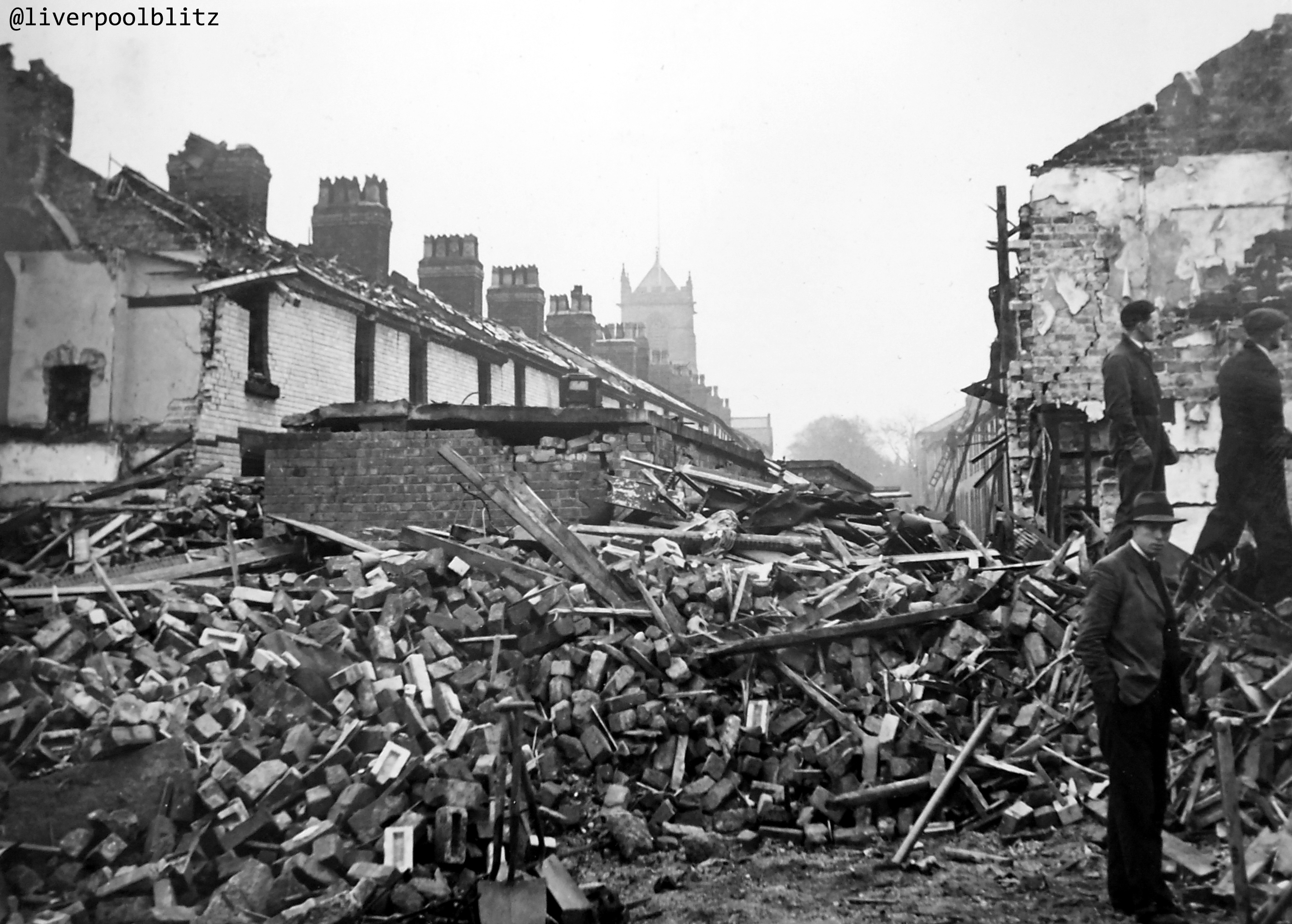 Lancaster Avenue blitz damage |
|
|
Emails HMS Thetis HMS Thetis sank off the Wallasey shore and was seen by Tom North who tells me: I am a merseysider, Born in Wallasey in 1939 and spent many hours playing on Leasowe sands while growing up. Two things of particular mention was finding a 500lb bomb buried in the sands. A jeep from the RAF station from Hoylake (RAF West Kirby) blew it up with a satchel charge after the local bobby phoned in with our report. It left a swimming pool sized hole that was gone after a couple of tides. What also comes to mind is a submarine (ours) that could not surface after its first test dive. The rear end was sighted sticking in the air and reported. There was a complement of Cammell Lairds workers on board as well as the new crew. It took longer than it should have to rescue because Navy/Shipyard responsibility was in doubt. The sands were often used for motorcycle racing when the tide was out. Enjoyed your web pages , bring back fond memories. THANKS Tom North. Currently living in Nanaimo , BC , Canada. From Al Etherington 1 Nov 2008: I was originally from Seacombe, born there in 1941, left for Canada in 1965 with my family. I have been trying to do my family tree, we lived at 14 Alfred Road Seacombe, and my granddad lived at 16. as a kid in the 40's I seem to remember saying it was named Havelock Street. Then named Alfred Road sometime between 1900 and 1930, also I was trying to find out who lived on this street between 1930 to 1945, can anyone help? I only ask as your mention of Havelock street is the first that I have come across other than an old 1900 map of the area.
Al Etherington
emailed me on November 5th 2008:
Your site has brought a lot of memories back from my childhood day's in Wallasey
and area's. When as a kid on the early 50's I had walked most of the places you
mentioned. On a Sunday morning around 9am with a bag of butties a gang of us
(5-6) would set off from Seacombe Ferry along the prom to New Brighton then
along the beach's to Hilbre Island, down to West Kirby, and back across the
peninsular via Frankby, Greasby, Upton and home, on the way we did a bit of
scrumping as our sarnies had long gone, getting home around 5-6pm,in those day's
you did not have to worry about being beat up or abducted, and our mums where
glad to see the back of us for a few hours, as we all came from large families I
was the eldest of 7, and we lived right near the docks, nobody locked their
doors, as a matter of fact when you needed to lock your door if you where going
a way for a few days you used have to borrow some ones key, as there was only
about 3-4 left on the street of 16 houses and they all had the same locks. January 2009: Got this email from Gavin Littler: I was brought up in the Travellers Rest pub in New Brighton, my father was the landlord there from 1958 to1965. New Brighton in winter was like a small village without all the coach loads of visitors. Maybe you could tell me the name of the little pub that used to stand opposite Seacombe Ferry, I think it had a nick name, breezes? (Me: I think I recall this pub, it was directly opposite the Ferry, facing it. I seem to recall a green frontage? Anybody got any ideas?) February 2009: Dave Taylor replied to the above: "The Marine Hotel' also known as Brasseys, (after Thomas Brassey I think). The pub was demolished a long time ago now with houses on the site, It was a small very cosy proper pub. March 25th 2009: There are allegedly secret tunnels, or what were secret tunnels, like a rabbit warren beneath Wallasey. Smugglers landed stock at New Brighton's Yellow noses and then vanished beneath the town!! Sian Evans has been in touch with me about these. She has heard that an entrance to these tunnels exists in Wellington Road and that they are supposedly open to the public on 1 day per year. Does anyone have any information on this? http://www.youtube.com/watch?v=AERg_hNSjHM Tunnels underneath New Brighton. Commentary by Mr Wilkie, Palace Amusements |
Email from Ross Goodman - Sept 2014 My name is Ross
Goodman currently resident in NZ but born in Wallasey and raised in
Manor Drive (when there were fields to look across to Bidston Hill. I
went to Barnston Lane Primary, Moreton Middle School and then on to
Oldershaw Grammar before moving to NZ in 1974. Your photos have left me
stunned, literally, as there are so many memories coursing through my
head that it is hard to process them all at once. I used to walk from
Manor Drive to BL every day so my memories of the town centre are very
strong to this day (can’t find my damned car keys though and I only put
them down 2 minutes ago). Wallasey Village & Liscard are already here Ross, on their own pages! July 2010: From Yvonne Longbottom. Thanks for your great website and the superb old pictures. I lived in Egremont, Wallasey, Cheshire from 4-19 in the forties, fifties and till 1961 when we emigrated to Australia, where I now live in Brisbane. You have taught me much about the history I did not know. One of your readers asked the name of the pub opposite the Seacombe Ferry. Im not really sure, but I seem to remember it being called, The Railway. I know its licensee during the fifties was a Mr Horton, because my first boyfriend was his son, Fred Horton, and his elder sister worked in Barclays Bank in King Street. It was on the hill going up towards Guinea Gap baths, right next door to the railway station. Its heartbreaking to see what has happened to the town. My school, Wallasey High School gone! My church, St Columbas gone! Mother Redcaps gone (unbelievable!!)! The New Brighton Tower Ballroom gone! The fairground gone! The Gaumont Cinema on the corner of King Street and Trafalgar Road gone! New Brighton Baths gone! Even my home at 29 Trafalgar Road, opposite the Nelson Hotel, whilst still standing, is now so derelict I am ashamed to say I lived there with my parents and my grandparents. I know that it, too, will be gone in the short term, and maybe it is better than to see it so fallen into decay. I spent so many happy hours of my childhood looking out of the bay window in Grannys comfortable sitting room, watching the big ships coming and going up the Mersey, being towed by the tugboats, or the New Brighton ferries scudding by. The view was only a small bit, so I could only see portions of the ship at a time. I remember seeing the Cunard Liner, the Mauritania and a lot of Blue Star Line ships. I could read the names on the side of the bow. Recently I watched a TV series, Lilies and there was a scene where the girls took the orphaned children to the shore for the day, and I am sure that the scenes were shot around the New Brighton Lighthouse. Is that correct? Thanks again for a nostalgic trip back to my childhood. It�s been a great day for me. Regards. Yvonne Allison used to be Longbottom. Unfortunately I cannot reply to Yvonne as her email address as portrayed is 'undeliverable'? July 2010: From Elizabeth Griffin. I lived in Wallasey from 1952 till 1977, attending Ss Peter & Paul Primary School (still there), Marymount Convent, Liscard (gone) & Maris Stella High (gone). Among many other memories, I can remember looking down the main street in New Brighton & seeing the Cunard Liners sail past, dwarfing the buildings & sending perspective haywire. Your details about the history of St Hilary's was fascinating. Thank you! |
|
http://www.disused-stations.org.uk/s/seacombe/index.shtml there were many links in here, but on checking, found nearly all had vanished online |
Wallasey Videos: http://www.youtube.com/watch?v=gH59hHwDxZc&feature=youtu.be http://www.youtube.com/watch?v=nmw8yIlVsUU&feature=related http://www.youtube.com/watch?v=zciRmnvQAVA&feature=related http://www.youtube.com/watch?v=FBjpUkH1Uuw&feature=related (I understand we have Kev
Byrne to thank for posting the wallasey videos on YouTube. https://www.youtube.com/watch?v=yIkGIJdUmnc Wallaseys Picture houses
|